#real estate discount services
Explore tagged Tumblr posts
Text
Froggie's (Almost) Very Productive Day
I try to fit as many out-and-about chores as possible into a single day so I only have one set of post-exertional malaise consequences instead of consequences after each day of doing a thing. So any time I decide to drive, I try to find several tasks to accomplish all at once.
My first stop was the Family Services Division in the hopes of getting some help with grocery bills. I am making ends meet, but it seems to be getting harder each month. And maybe I could have skipped my trip to Florida and saved that money, but if I don't do something drastic for my mental health, I fear this first holiday season without a parent could send me into the darkness.
I needed to do an interview to finish applying for SNAP. I wanted to do a phone interview, but the next appointment was in January. So I went to social services where they allow walk-in appointments. I waited in a tiny plastic chair for several hours until they called my name. She yelled out "Benjamin" because when most people see "Grelle" they aren't really sure how to say it. (Rhymes with belly.)
She started my interview and it was going swimmingly at first. But then she started asking questions about the house and my inheritance and my trust. I had no idea what to tell her. It feels like a mistake now, but I have had pretty much no involvement in that process. I have no idea how it works. And I started to panic because she was acting like I was committing fraud or something by not mentioning the trust. But the entire point of the trust was to protect my benefits. Nothing is mine. I own nothing. I have no access. But I had no idea how to explain that.
Maybe my lawyer can help me apply, but I did not want them investigating everything and screwing things up before we even have the estate through probate. We specifically hired a lawyer and went through this convoluted process to make sure everything was on the up and up. But she really made me feel like I was doing something wrong. And that made me panic, which probably made me look even more guilty of something. So I just canceled everything and left.
After a few hours in a crowded government office, I decided to head to a different crowded government office.
I know I didn't need it until 2025, but I decided to go ahead and get my Real ID thingie before my first flight. I was kind of hoping they'd retake my picture because my current driver's license is... well...
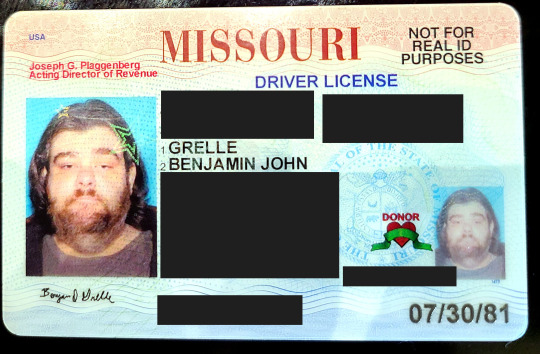
And I'm so glad they took my big terrible picture and made it into a smaller, more terrible picture.

People complain about the DMV, but the one near me runs like a machine. It was filled with people and I still only had a 10 minute wait time.
I'm starting to wonder if all of those 80s comedians who were all, "What's the deal with the DMV?" were exaggerating.

Good stuff, Jerry.
I head up to the counter and ask for a Real ID. She asks for two pieces of mail and my birth certificate.
And this disappointed me a little bit.
I did my research. I went to the Real ID website and used their interactive guide to figure out exactly which documents I would need. They gave me this entire checklist and I printed it out and went through all my records and mail trying to find everything.

I had to wait a week for my internet bill to come because it's the only thing I forgot to change to paperless. This took a lot of effort and I was ready to be validated for being so prepared.
And she asks for two pieces of mail.
Any mail.
So I was off to get new tires.

Driving around on 8 year old bald tires was giving me anxiety. I didn't have the money for new tires, but I remember the guy saying they had financing. Recently several of my past debts went past the statute of limitations, and so my credit score lifted itself out of the pits of "poor" and into the realm of "fair." So I decided to take a chance and apply for a Discount Tire credit card. It's a 6 month payment plan with no interest, so that didn't feel as predatory as all the credit card offers I get in the mail with 8000% interest.
We started going through the approval process and I was answering all of the questions and then I saw the name of the bank offering the credit. It was the same bank that tried to sue me and also the bank that can longer collect due to the statute. I was worried they put me on some sort of list and would deny me. But, to my surprise, they approved me instantly. And wouldn't you know it, they gave me almost exactly the amount needed for a new set of tires.
I'm hoping we'll be doing another auction of the house stuff soon, so I plan to pay off the card and then cancel it, but this was the only solution I could come up with to drive safely until then.
I was having a weird day where photos of crusty rich wide dudes followed me everywhere I went. Here is my good ol' boy governor at the entrance to social services.
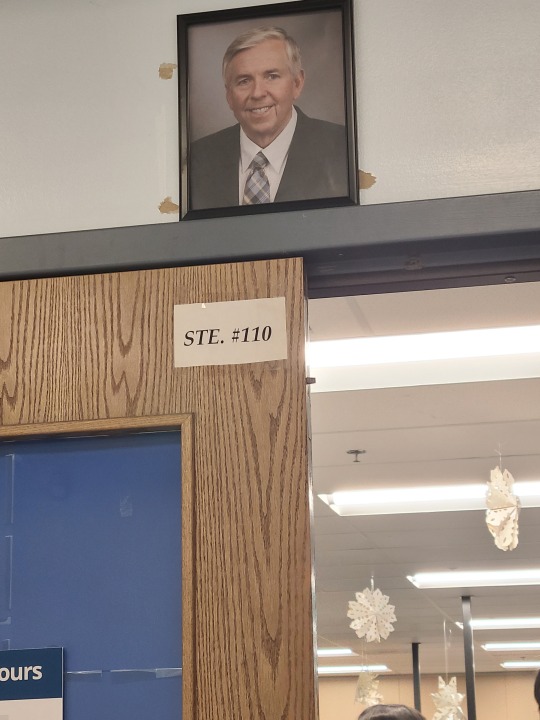
And at the tire place, I noticed this fella...

Why does every rich CEO think they are a font of wisdom capable of creating compelling quotes?
Does he think no one has ever said "work hard" and "have fun"? And after he said this was he like...
"That's gold, put that in *every* store."
"Oh, and use that picture of me where it looks like a handsome gal just grabbed my undercarriage."

He probably thinks, "Well, no one has put these specific generic platitudes together into a single mega-platitude. I am a genius."
"Be honest, work hard, have fun, be grateful, pay it forward" sounds like he had a bunch of motivational posters on his wall and started reading them all at once.
Like, every line could have a picture of an eagle above it.

In any case, the guy at the tire store, Dakota, was really nice. He made the experience very low anxiety. And he really liked my Thor's Hammer keychain with built in fidget spinner.
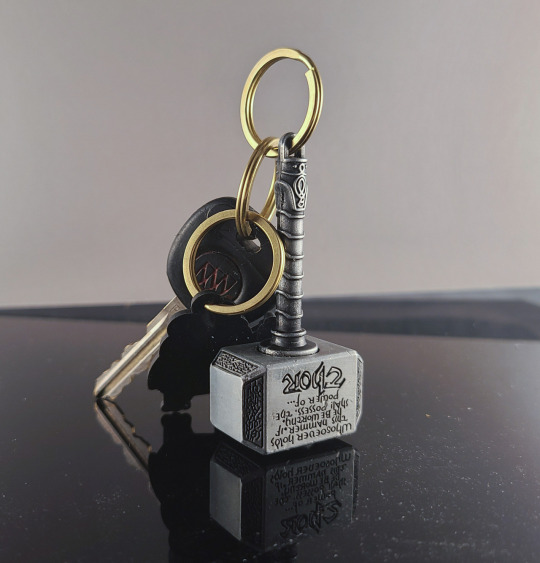
He went around showing it to all his coworkers. "Look, it even spins!" And they were like, "Dude, where did you get that??" And I was like, "Amazon." Now I'm just imagining 10 dudes at a tire store all fidgeting their hammers.
As nice as he was, Dakota was still a salesman and had a job to do. He gave me two tire options and tried to upsell me. The cheapest tires had a "1" rating for winter. He said they get "super hard" in the cold... I tried not to giggle. But I explained I drive about twice a month and mostly to the grocery store. If it is a bad winter day, I'll just wait or get delivery. He understood and set me up with the cheaper tires.
He then checked out my car and noticed my tire pressure sensors were dying. I keep getting a warning light on my dash. Apparently they all have tiny batteries in them that die after 7 years. And you can't just replace the batteries so you have to install brand new sensors.
And this is where my social anxiety got me into trouble.
I don't actually need these sensors. They are usually inaccurate. I prefer to test my tires with an actual gauge. But I got so caught up in his sales pitch that I agreed to replace them... at $60 each. For that I could have gotten the fancier tires. I really don't care if an orange light shows up on my dash. And I looked up the price online and a pack of 4 is $30. Though that is without installation.
But still... I wasn't thinking and he was so nice that I was just like, "I want to please Dakota. Saying no might make Dakota sad." Dakota's job is selling me but that doesn't mean I have to buy anything. He would live if I had said "no thanks."
To make my blunder more blunderous, when they finished the tires he asked for my key fob. And it decided that was the time for the battery to die. And in order to reset the system for the new tire pressure sensors, you have to press two buttons on the fob for 7 seconds. Thankfully I had a spare fob at home, but if I want my fancy new $240 sensors to work, I have to return to Dakota and have him initialize them.
I really hope these are the Cadillac of sensors.
Or, like, the ones they use on Cadillacs?
They better be accurate, is what I'm saying.
I do feel safer with new tires. So I am glad I did that. And I gave them a good obligatory kick and felt the tread. They seem nice enough even if they get boners in the winter. It's crazy how bald my other tires were in comparison. Like, I can fit half my finger down into the tread on the new ones—which did not get them super hard.
The way I drive, I probably won't wear them down. They'll probably start to rot before I do.
Before I do, meaning before I wear them down.
Not before I rot.
I am not in a rotting competition with my tires.
I was then off to Sam's. I decided all of my hard work accomplishing 2 out of 3 goals deserved some sushi. So I grabbed some California Rolls and headed home. On my way out, a Hummer and a Porsche nearly collided in the parking lot. And they sort of got stuck facing each other. One of them needed to back up and they both signaled at each other like "You back up, I'm not backing up." And it was just this weird standoff between the two douchiest looking cars you could imagine.
I mean, you have to be a douche to drive a Hummer.
I still remember the mystery Hummer dialysis patient from when my dad was going 3 time per week. We could never figure out who owned the Hummer, but we knew it was not the underpaid nurses and techs. So it had to be one of the patients. And none of them seemed the type. We never solved that mystery.
That hummer started off a delightful safety yellow. (Elon would cry.)


They decided this wasn't extra enough... so they did this...

Katrina and I could never decide... are these cow spots or the world's least effective camoflauge?
There was another patient who drove this old beater...

And I loved seeing this car because we had the same one when I was a little kid. I'm afraid the aesthetics of the 1980s Caprice Classic did not stand the test of time, but it had great sentimental appeal for me.
But this maroon beast that squeaked and sputtered its way from here to there belonged to a very sweet older gentleman. Sometimes he and my dad would be dialysis buddies—sitting next to each other in the recliners. And the worst thing about dialysis was the boredom. All you have to do is watch broadcast TV with 4 channels.
All of the TVs require headphones. They give you your own set of super cheap headphones in the dialysis welcome bag. They were very uncomfortable so I ordered my dad better ones with cushioned ear cups.

His dialysis buddy noticed them and thought they looked nice. And then he revealed that his free headphones broke and he didn't know how to get new ones. He had been watching TV with no sound for weeks. So, I bought another pair with the soft ear cups and my dad gave them to his friend. And it just made me happy imagining the two of them watching The Price is Right in matching headphones.
I do have to make fun of this sweet old man a little bit. When I walked passed his car I noticed he implemented the world's most effective anti-theft device ever created.

That's right... The Club™.

If someone decides they have to have a 40 year old car with an engine that sounds like a dying hyena and a hubcap missing... they are out of luck.
But hey, you gotta protect what is important to you. And if I needed a getaway car and my choices were between his beater and the Cow Hummer, I'd take his ride for sure.
Well, I'd try... and then get arrested because The Club™ is undefeatable.
Do NOT look that up on YouTube. It's 100% true. (And the Lock Picking Lawyer doesn't count due to him being able to break into Fort Knox with a paperclip and then doing it again to make sure it isn't a fluke.)
The dialysis center is in the same complex as my local Tolerable Schnucks and I still see that maroon boat of a car every once in a while. I always smile whenever it is there because it lets me know he is hanging in there and hopefully still has sound for his TV.
Wow, I went off on a mega-tangent.
I didn't even finish talking about my day. Where was I? Oh, the douche standoff finally ended. The Porsche Douche capitulated and backed up. Probably due to the fact the Hummer Douche has 0 visibility behind him.
When I got home I started devouring my sushi. I finally heard back from my lawyer. He submitted the last of the evidence for my appeal. And I was finally able to confirm he got the records of my ECT treatments from 20 years ago. I worked so hard to get those. At first, they forgot to send all records before 2011. I had to call back and figure that out. They shipped them and they didn't arrive until a week before we had to file. Everything was so last minute and my anxiety has been... palpable. It felt like when I did my science fair project on Sunday night.
He's hoping to get a decision at the beginning of next year. He warned me that these appeals are usually rejected. And that the most effective method of approval was a hearing in front of an administrative law judge. But that could be delayed by up to a year. So I might need to figure out how to survive until 2025. As long as my brother does what he is legally required to do, I should be okay. But counting on that also gives me palpable anxiety.
And that was my day.
Every time I go out is always an adventure.
But remember...
BE NICE. EAT YOUR VEGGIES. PET CUTE DOGS. DREAM BIG. KEEP YOUR TIRES WARM... FOR REASONS. 5 LIFE LESSONS -Froggie, Mildly Famous Internet Person

210 notes
·
View notes
Text

Life Spa Resort, under the inspired leadership of African American founders Allen and Melissa Brown, proudly announces the launch of a fundraising campaign to raise $12 million to open the Poconos' first Black-owned hotel spa resort. With a proven track record as successful entrepreneurs holding nearly $2 million in commercial real estate assets since 2021, the Browns are poised to transform the Poconos into a premier destination for health and relaxation.
Embarking on a Groundbreaking Journey
Allen and Melissa are currently in contract and looking to close the acquisition of the resort property by mid-September. Development will commence immediately thereafter, including the installation of state-of-the-art social wellness hydrotherapy pools that can accommodate 200-300 people at a time.
Transforming Wellness in the Poconos
The focus of Life Spa Resort is to establish a hydrotherapy and spa facility that is unparalleled in the region. Hydrotherapy, known for its significant health benefits, will be the cornerstone of their offerings. The resort will cater to up to 200 guests daily, providing treatments that promote relaxation, rejuvenation, and healing in a serene setting.
Support from Early Backers
Life Spa Resort invites early backers to join this transformative project by contributing as little as $10. Backers can gain lifetime memberships and enjoy benefits including spa treatments at discounts of up to 80%. This unique opportunity allows individuals to be part of a pioneering wellness community from the ground up. Moreover, lifetime early backers will be able to use their benefits at any and all locations that Life Spa Resort opens in the future, ensuring enduring value across a growing network of wellness destinations.
Investor Opportunity
Accredited investors are sought for this venture under Regulation D, Rule 506(c), which allows public solicitation of a private offering to those who meet the SEC's criteria for accreditation. The Private Placement Memorandum, available for detailed review on Life Spa Resort's website, presents a compelling investment opportunity. Investors can expect projected returns of 12-15% annually, emphasizing the robust financial model and growth potential of Life Spa Resort. The Memorandum includes clear investment terms and extensive plans for facilities such as hydrotherapy pools, specialized sauna rooms, and a comprehensive suite of wellness services.
About the Owners
Allen and Melissa Brown have been pivotal figures in the hospitality and real estate sectors since 2021, managing multiple successful properties and building a strong financial foundation. Their commitment to creating a legacy of health, relaxation, and financial prosperity through innovative projects like Life Spa Resort is poised to redefine industry standards. They have also maintained Airbnb Super-host status for three years, further highlighting their commitment to excellence in hospitality and guest services. Visit LifeSpaResort.com for more information.
Also, be sure to follow the resort on Facebook and Instagram.


#fortheculture❤️🖤💚🙋🏿♂️🤴🏿🌍🎤#blackpowerinthismfer❤️🖤💚🙋🏿♂️🤴🏿✊🏿🎤#supportblackentrepreneurs#melanin excellence
15 notes
·
View notes
Text
The 6% commission, a standard in home purchase transactions, is no more. In a sweeping move expected to dramatically reduce the cost of buying and selling a home, the National Association of Realtors announced Friday a settlement with groups of homesellers, agreeing to end landmark antitrust lawsuits by paying $418 million in damages and eliminating rules on commissions. The NAR, which represents more than 1 million Realtors, also agreed to put in place a set of new rules. One prohibits agents’ compensation from being included on listings placed on local centralized listing portals known as multiple listing services, which critics say led brokers to push more expensive properties on customers. Another ends requirements that brokers subscribe to multiple listing services — many of which are owned by NAR subsidiaries — where homes are given a wide viewing in a local market. Another new rule will require buyers’ brokers to enter into written agreements with their buyers. The agreement effectively will destroy the current homebuying and selling business model, in which sellers pay both their broker and a buyer’s broker, which critics say have driven housing prices artificially higher. By some estimates, real estate commissions are expected to fall 25% to 50%, according to TD Cowen Insights. This will open up opportunities for alternative models of selling real estate that already exist but don’t have much market share, including flat-fee and discount brokerages. Shares of real estate firms Zillow and Compass both fell by more than 13% Friday as investors feared that lower commission rates for agents could lead to less business for real estate platforms. In a 10-K filing last month, Zillow warned that, “if agent commissions are meaningfully impacted, it could reduce the marketing budgets of real estate partners or reduce the number of real estate partners participating in the industry, which could adversely affect our financial condition and results of operations.” Shares of real estate brokerage Redfin also fell nearly 5%. Meanwhile, homebuilder stocks rose on the news: Lennar shares gained 2.4%, PulteGroup shares added 1.1% and Toll Brothers shares added 1.8%. For the average-priced American home for sale — $417,000 — sellers are paying more than $25,000 in brokerage fees. Those costs are passed on to the buyer, boosting the price of homes in America. That fee could fall by between $6,000 and $12,000, according to TD Cowen Insights’ analysis.
47 notes
·
View notes
Text
Thai Elite Visa
The Thai Elite Visa, managed by the Thailand Privilege Card Company Limited under the Ministry of Tourism and Sports, is a government-endorsed residency program. Offering a mix of long-term stay options and exclusive benefits, the visa caters to affluent individuals, retirees, business professionals, and frequent travelers. It combines convenience with lifestyle perks, making it one of Thailand's most attractive residency solutions.
1. Overview of the Thai Elite Visa
The Thai Elite Visa allows for long-term residency ranging from 5 to 20 years, depending on the selected package. It includes multi-entry privileges, expedited immigration processing, and access to premium services, making it ideal for those seeking stability in Thailand without the complexity of visa renewals.
2. Core Benefits
Residency Convenience:
Validity for up to 20 years without the need for frequent renewals.
Simplified annual reporting instead of the standard 90-day reporting for other visa types.
Airport and Travel Services:
Fast-track immigration services at major Thai airports.
Access to luxury airport lounges and personal assistance upon arrival and departure.
Premium Lifestyle Perks:
Discounts at hotels, golf courses, spas, and medical facilities.
Annual health check-ups at leading hospitals in Thailand.
Family-Friendly Options:
Specific packages allow family members to join with reduced fees.
3. Membership Packages
3.1 Elite Easy Access
Duration: 5 years.
Cost: 600,000 THB.
Ideal For: Frequent visitors or those seeking medium-term stays.
3.2 Elite Privilege Access
Duration: 10 years.
Cost: 1 million THB.
Best For: Long-term residents seeking premium lifestyle benefits.
3.3 Elite Superiority Extension
Duration: 20 years.
Cost: 1 million THB.
Focus: Affordable extended residency for long-term stability.
3.4 Elite Ultimate Privilege
Duration: 20 years.
Cost: 2.14 million THB.
Exclusive Features: Additional concierge services, medical benefits, and bespoke support.
3.5 Family Packages:
Elite Family Excursion (5 years): 800,000 THB for two members.
Elite Family Premium (10 years): 1 million THB for the principal member and 800,000 THB per additional family member.
4. Eligibility and Application Process
Eligibility Requirements:
Open to individuals of all nationalities.
Must be at least 20 years old (for some packages).
Applicants must not have a criminal record.
Application Steps:
Document Submission:
Passport copies, completed application form, and recent photographs.
Fee Payment:
Membership fees must be paid upon application approval.
Visa Collection:
The visa can be collected from a Thai embassy, consulate, or immigration office.
5. Limitations of the Thai Elite Visa
No Path to Citizenship:
The visa does not offer a route to permanent residency or Thai citizenship.
Employment Restrictions:
The visa does not include a work permit. Separate applications are required for those intending to work.
Cost Implications:
The upfront fee may not suit those seeking short-term or low-cost residency options.
6. Tax and Legal Considerations
Tax Residency:
Holding a Thai Elite Visa does not automatically make the holder a tax resident. To qualify, the individual must spend at least 180 days annually in Thailand.
Income Tax:
Income earned in Thailand is subject to Thai tax laws.
Re-Entry Permits:
Multi-entry privileges simplify travel, reducing the need for re-entry permits.
7. Contribution to the Thai Economy
Tourism and Hospitality:
Visa holders contribute significantly to Thailand’s tourism and luxury service sectors.
Real Estate Investment:
Many holders invest in condominiums, supporting the property market.
Economic Stability:
The program attracts high-net-worth individuals, adding foreign revenue and promoting local economic activity.
Conclusion
The Thai Elite Visa offers an unparalleled combination of long-term residency, exclusive services, and premium benefits, making it ideal for those looking to establish a stable presence in Thailand. While it comes with a significant financial commitment, the visa's convenience and lifestyle advantages make it a worthwhile investment for those who meet its criteria. Applicants are encouraged to consult with legal and financial experts to fully understand their options and responsibilities.
#thailand#thai#visa#thaivisa#immigration#immigrationlawyers#immigrationinthailand#immigrationlawyersinthailand#elitevisa#thaielitevisa#visainthailand#visathai
3 notes
·
View notes
Text
How to Find the Best Deals When Buying Villas in Dubai
Securing the best deals on villas in Dubai requires a combination of market knowledge, strategic planning, and effective negotiation. Here’s how you can find the best deals when buying villas in this vibrant city.
1. Conduct Thorough Market Research
Understanding the market dynamics is crucial for finding the best deals.
Current Market Trends: Stay updated with the latest market trends and property prices in different areas of Dubai. This will help you identify the right time to buy.
Historical Data: Analyze historical data on property prices to understand the market’s performance over the years. This can give you insights into potential future trends.
For comprehensive market insights, visit Dubai Real Estate.
2. Choose the Right Time to Buy
Timing your purchase can significantly impact the deal you get.
Buyer’s Market: Look for periods when there is a surplus of properties on the market. This can drive prices down and provide better negotiation opportunities.
Seasonal Trends: Consider buying during off-peak seasons when the demand is lower. Sellers may be more willing to negotiate during these times.
Explore more options at Off-Plan Projects in UAE.
3. Work with Experienced Real Estate Agents
A knowledgeable real estate agent can be invaluable in finding the best deals.
Reputable Agents: Choose agents with a strong track record and good knowledge of the Dubai villa market. They can provide valuable insights and help you navigate the buying process.
Negotiation Skills: An experienced agent can negotiate better deals on your behalf and help you understand the intricacies of the market.
For expert advice, check out Mortgage Broker Dubai.
4. Consider Off-Plan and Under-Construction Properties
Off-plan and under-construction properties can offer attractive pricing and payment plans.
Early Bird Discounts: Developers often offer discounts for early buyers. These discounts can be substantial and provide good value for money.
Flexible Payment Plans: Off-plan properties typically come with flexible payment plans, making it easier to manage your finances.
Learn more about off-plan properties at Under-Construction Properties in Dubai.
5. Negotiate Effectively
Effective negotiation can help you secure a better deal.
Be Prepared: Do your homework and know the market value of the property. This will give you a strong negotiating position.
Stay Flexible: Be open to compromises and alternative solutions. Sometimes, a small concession can lead to a significant overall saving.
For more negotiation tips, visit Best Mortgage Services.
6. Utilize Online Property Portals
Online property portals can be a great resource for finding deals.
Comprehensive Listings: Use reputable online portals that offer comprehensive listings of properties. This can help you compare prices and features.
Direct Deals: Some portals facilitate direct deals between buyers and sellers, potentially eliminating agent fees and providing better deals.
For more property listings, check out Property For Sale in Dubai.
7. Attend Property Exhibitions and Events
Property exhibitions and events can provide opportunities to find exclusive deals.
Developer Discounts: Many developers offer special discounts and promotions at these events.
Networking Opportunities: These events provide an opportunity to network with developers, agents, and other buyers, which can lead to valuable insights and deals.
Explore more at Rent Your Property in Dubai.
Conclusion
Finding the best deals when buying villas in Dubai involves a combination of thorough research, strategic planning, and effective negotiation. By staying informed about market trends, choosing the right time to buy, working with experienced agents, and considering off-plan properties, you can secure the best deals and make a smart investment in Dubai’s vibrant real estate market.
For more information and assistance with buying villas in Dubai, visit Home Loan UAE.
9 notes
·
View notes
Text
Thailand Privilege Visa
The Thailand Privilege Visa, commonly known as the Thailand Elite Visa, is a long-term residency program designed for affluent individuals seeking an extended stay in Thailand with exclusive benefits. Managed by the Thailand Privilege Card Company Limited, this program is part of the government’s initiative to attract high-net-worth individuals and boost tourism and investment.
1. Purpose and Target Audience
1.1 Objectives
To promote Thailand as a desirable destination for living and business.
To attract affluent foreign nationals and encourage investment in tourism, real estate, and other sectors.
1.2 Target Audience
High-net-worth individuals.
Retirees seeking long-term residency.
Frequent travelers who value premium services.
Businesspeople managing regional operations.
2. Membership Packages
The Thailand Privilege Visa offers several membership options tailored to different needs:
2.1 Elite Easy Access
Duration: 5 years.
Cost: 600,000 THB.
Best For: Individuals seeking flexibility for frequent visits.
2.2 Elite Family Excursion
Duration: 5 years for two family members.
Cost: 800,000 THB.
Additional Family Member Fee: 300,000 THB.
Best For: Families traveling together.
2.3 Elite Superiority Extension
Duration: 20 years.
Cost: 1 million THB.
Best For: Long-term residents seeking stability.
2.4 Elite Privilege Access
Duration: 10 years.
Cost: 1 million THB.
Additional Family Member Fee: 800,000 THB.
Best For: Individuals or families requiring medium-term flexibility.
2.5 Elite Ultimate Privilege
Duration: 20 years.
Cost: 2.14 million THB.
Best For: High-net-worth individuals desiring the highest level of privileges.
3. Benefits of the Thailand Privilege Visa
Extended Stay Options:
Stay for up to 20 years without visa renewals.
Multiple entries allowed, with each entry permitting a 1-year stay.
Airport Services:
VIP fast-track immigration and security clearance.
Access to luxury airport lounges.
Government Liaison Services:
Assistance with 90-day reporting, visa renewals, and driving licenses.
Healthcare and Lifestyle Benefits:
Discounts at top hospitals, golf courses, spas, and hotels.
Family Inclusion:
Options for family members to be included at reduced rates in certain packages.
4. Application Process
4.1 Eligibility Requirements
No age restrictions, but applicants must have no criminal record and meet financial thresholds.
4.2 Steps to Apply
Membership Application:
Submit an application with a valid passport and personal information.
Approval and Payment:
Once approved, pay the membership fee to the Thailand Privilege Card Company.
Visa Issuance:
Obtain the visa at a Thai embassy, consulate, or immigration office.
5. Limitations and Considerations
Non-Work Visa:
The Elite Visa does not permit employment without an additional work permit.
Cost-Effectiveness:
High upfront costs may not suit all applicants, especially those with shorter-term plans.
No Permanent Residency Path:
The Thailand Privilege Visa does not lead directly to permanent residency or citizenship.
6. Practical Applications
For Retirees:
Offers a hassle-free long-term residency option with healthcare discounts.
For Frequent Travelers:
Simplifies immigration processes for business or leisure trips.
For Investors:
Provides long-term stability while managing investments in Thailand.
Conclusion
The Thailand Privilege Visa program is an innovative solution for affluent individuals and families seeking a premium residency experience. While the program offers unparalleled convenience and benefits, applicants must carefully consider their long-term plans and financial capacity to maximize its advantages. Engaging with authorized consultants or legal professionals ensures a smooth application process and clarity on the program’s terms.
#thailand#lawyers#attorneys#immigration in thailand#immigration lawyers in thailand#immigration#thai#visa#thaivisa#privilegevisa#thaiprivilegevisa#privilegevisainthailand
2 notes
·
View notes
Text

Croupier Comptable: Game Theory for The Venetian Macao, China (Trapping Aesthetic for Volleyball) 14K
BIO
My Name is Adrian Blake-Trotman. I am Indo-Mediterranean Caribbean Born in Toronto but From Barbados and Haiti. I am a Beta-arbitrage Mergers & Acquisitions Banker that Specializes in Commodities. I have Understanding Financial Markets by Université de Genève and Monetary Policy in the Asian-Pacific by Hong Kong University of Science and Technology with No Gr. 12 Math or Intro to Linear Algebra; I built a mathematical learning style by using Japanese Candlesticks Bullish Engulfing Discounted Cash Flow Charts for Poker. I Operate TAX AVOIDANCE through Freelance Mergers & Acquisitions through an Enterprise Foundation and Investment Trust. My background is Agriculture Working Class, I've worked in Kitchens and Grocery Stores. My goal is to connect the Democratic Republic of the Congo to two tax havens; Haiti & Seychelles to stabilize the Diamond Trade and more Important the Commodities Market. Through Mercantilism Agriculture Hedge Fund as a Central Bank, Options Volatility Exchange, Lab Grown Re-sale Market, Decentralized Currency and Fiat Money, Hospitality & Gaming. Also To form a Socioeconomic Status Agriculture Working Class; Blue, Pink, and White Collar Jobs. I am Modelling my Cartel off of Wall Street for De Beers but is owned and operated by the Société des Bains de Mer (SBM); The Casino de Monte-Carlo is owned and operated by the Société des Bains de Mer (SBM), a public company in which the government of Monaco and the ruling princely family have a majority interest. The company also owns the principal hotels, sports clubs, food service establishments, and nightclubs throughout the Principality. The Société des Bains de Mer operates in the accommodation, dining, entertainment, and gambling services. SBM manages and owns casinos, hotels, restaurants, bars, nightclubs, spas, beach clubs, and golf clubs. Fifty-two of their fifty-eight properties are located in Monaco. The concept of state-corporate crime refers to crimes that result from the relationship between the policies of the state and the policies and practices of commercially motivated corporations. The term was coined by Kramer and Michalowski in 1990.
THE ARNAULT MODEL: BALANCING FINANCIAL DISCIPLINE AND CREATIVITY
Over the next three decades, as he brought the best luxury brands in fashion, cosmetics, and beverages under the LVMH umbrella, Arnault proceeded to make “a series of brilliant business decisions” that “can only be called masterful.” Even his critics were impressed by “his ability to manage creativity for the sake of profit and growth.” Industry observers frequently credit his outstanding success in a highly competitive industry to the fact that—unlike other global CEOs—Arnault understands both the creative and the financial aspects of running a luxury business
Financed through Real Estate and Convertible Bonds
The Creation of Star Brands
In a 2001 Harvard Business Review interview, Arnault explained his famous business process, which—unlike the traditional fashion industry—requires financial discipline as well as creativity. The entire focus of Arnault's teams is the creation of “star brands” that must meet a high bar for four artistic and financial criteria: LVMH brands must be “timeless, modern, fast-growing, and highly profitable.” In practice, “profitable creativity” means that “star brands are born only when a company manages to make products that ‘speak to the ages’ but feel ‘intensely modern’ and ‘sell fast and furiously, all while raking in profits
Although the LVMH process begins with "radical innovation—an unpredictable, messy, highly emotional activity” on the creative end, as soon as “it comes to getting creativity onto shelves—chaos is banished,” and the company imposes "strict discipline on manufacturing processes, meticulously planning all 1,000 tasks in the construction of one purse.”
The genius of Arnault’s process is that, although the "front end of a star brand—the innovation…the creative process, the advertising—is very, very expensive,” the “back end of the process in the atelier (the factory)” is a place of "amazing discipline and rigor” that drives “high profitability behind the scenes.” Brands with “unbelievably high quality” require “unbelievably high productivity,” so “every single motion, every step of every process is carefully planned with the most modern and complete engineering technology.”
For example, when Arnault automated production at Vuitton, he drove that venerable old brand to the top spot on Fashionista’s list of the world's best-selling luxury brands in 2011, with a value of $24.3 billion—more than twice the amount of its nearest competitor.
As he spent “lavishly” on advertising, Arnault "rigorously" controlled costs by leveraging every possible synergy across the group: Kenzo manufactured a Christian Lacroix line; Givenchy manufactured a Kenzo perfume, and Guerlain created the first Vuitton perfume.
Creative Talent Management
As Arnault built LVMH into the world's largest luxury conglomerate, he hired new design talent for star brands that “speak to the ages” but “feel intensely modern”: from Céline, Kenzo, Guerlain, and Givenchy to Loewe, Thomas Pink, Fendi, and DKNY.
Because his model requires that “the counterbalance to creativity must be commerce,” Arnault “never hesitated to reign in, or outright terminate, creative executives who did not produce.” Since the early days at Dior, he has often replaced creative executives with non-traditional talent and then shuffled them across his brands to help him identify opportunities to drive profit—no matter how unpopular.
For example, at Givenchy in 1995, Arnault brought in a “fashion industry darling” and “notorious wild child,” British designer John Galliano, to replace Hubert de Givenchy, the industry icon “credited with defining simple elegance for an entire generation of women, (including) Audrey Hepburn, Jacqueline Kennedy, and the Duchess of Windsor.”
Within a year, Arnault moved Galliano, the first British designer in French haute couture, from Givenchy to Christian Dior to replace Gianfranco Ferré, the Italian couturier who had led Dior design since the late 1980s. Other non-traditional Arnault hires included installing 27-year-old Alexander McQueen (another British designer) at Givenchy and Marc Jacobs at Louis Vuitton, where he gave the American designer a mandate to challenge LVMH’s competitors, Prada and Gucci.
Although those iconoclastic designers later left LVMH, they had served Arnault’s purpose: interest in his traditional fashion houses had been jumpstarted by the early 21st century.
HOW TO STABILIZE THE DEMOCRATIC REPUBLIC OF THE CONGO, SEYCHELLOIS, AND HAITIAN CURRENCY (INDIAN PREMIER LEAGUE BUT FOR MMA & COMMODITIES NOT CRICKET & TECHNOLOGY MODEL)
Bioeconomy Agriculture Central Hedge Fund with Agriculture Bulge Brackets Oligopolistic System Hyper Inflation Vehicle Fiat Currency: Strict Negative Interest Rates for Investments; Debt/Equity Business Loan Period and Construction Loan/Tax Benefits Programs, Investment Trusts & Enterprise Foundations are Common Corporate Tax Avoidance Practices, and Raise Denominator of Currency & Print Currency for Insurance Companies for Building Process
Combat Sport as National Sport: Free Internet with Corporate Sponsor Purse Bid System Mixed Martial Arts Camps, Orphanages, Polytheist Churches, Gaming-Hospitality; and +EV Gambling
Mercantilism Fiat Currency Pegging: Foreign Exchange Rate to Diamond Peg Currency
Market Extension Vertical Integration Mergers Lottery
Industries: Mergers & Acquisitions Agriculture Industry, Decentralized Finance, Real Estate Finance and Economics, Capital Gains Tax Haven, Corporate Tax Haven, Inheritance Tax Haven, Art Ports, and Gaming-Hospitality
Blockchain Diamond-Metal Exchange Modelled Off of CBOE Volatility Index (VIX). Founded in 1973, the CBOE Options Exchange is the world's largest options exchange with contracts focusing on individual equities, indexes, and interest rates. Credit Spread Options and Blockchain the Commodities Market.
Business Capital is a Collaborative Environment through Generalized Education (STEM AND M & A)
Socioeconomic Status Agriculture Working Class Immigrants
XYY or Triple X Syndrome, ACTN3 Gene, MSTN Gene, and Mercury-Venus Births
A ROUND OF PAR GAME THEORY NETWORK
Beta Arbitrage with Convertible Bonds Compounding
Key Ingredients
Player's: Futures Exchange and Investor
Actions: Issue payments under any circumstances
Payoffs: Exchange - Larger Market Volume, Investor - Larger Assets Under Management or Profits
Representation
Extensive Form includes timing of moves. Player's move sequentially, represented as a tree (timing). Chess: the white player moves, then the black player can see White's move and react
Theory
There's a common expression of higher the risk, higher the reward; but in finance it should be higher reward, higher risk because people's savings are involved. This is why I created The Round of Par Games Theory Network where the intended score should always be 0. Nobody wins and nobody loses between investor and stock exchange, just a nice friendly draw. The Investors assets under management grows and the Exchange's Market Volume Grows.
Let's break down the Components:
Beta Arbitrage
Investor: Beta Arbitrage involves longing in one market and shorting in a DIFFERENT market. The example is longing Company A in the stock market but then going to Company A in the options market and placing a put/short option. Either way the Investor earns a profit.
Exchange: The Futures Exchange benefits because now not only is equity on the stock market is being bought but the options market has a larger volume.
Convertible Bond Compounding
Investor: By compounding through Convertible Bonds not only are you going to be paid back your money because creditors are first on the company's bankruptcy list unlike investors, but it's an easier way to buy more shares for growth investing while not diving head first.
Exchange: The Futures Exchange benefits because now not only is equity on the stock market is being bought, but the bond market has a larger volume.
LANGUAGES
Mandarin
Latin
INDUSTRY WORTH FOR COMMODITIES (AGRICULTURE WORKING CLASS)
In 2012, Forbes reported that $21 trillion was Off-Shored
In 2017 the equivalent of at least 10% of the world’s GDP is in offshore banks, and that number is probably higher due to the opaqueness of the world’s global tax havens, according to a research report release this month by the National Bureau of Economic Research.
The estimated amount of money laundered globally in one year is 2 - 5% of global GDP, or $800 billion - $2 trillion in current US dollars.
Taxes in the US – The federal government collected revenues of $3.5 trillion in 2019—equal to about 16.3 percent of gross domestic product (GDP) (figure 2). Over the past 50 years, federal revenue has averaged 17.4 percent of GDP, ranging from 20.0 percent (in 2000) to 14.6 percent (most recently in 2009 and 2010).
The foreign exchange or forex market is the largest financial market in the world – larger even than the stock market, with a daily volume of $6.6 trillion, according to the 2019 Triennial Central Bank Survey of FX and OTC derivatives markets.
In 2019, for example, the sales value of rough diamonds amounted to some 13.9 billion U.S. dollars worldwide. After polishing, the value increased by nearly double to 26.7 billion U.S. dollars. In 2019, the global diamond jewelry market value was approximately 79 billion U.S. dollars.
Global Cut Flowers Market to Reach $41. 1 Billion by 2027.
The global coffee market was valued at USD 102.02 billion in 2020,
Global Vanilla Market Is Expected to be worth Around USD 735 Million By 2026
According to the report published by Allied Market Research, the global cocoa market generated $12.8 billion in 2019, and is projected to reach $15.5 billion by 2027, witnessing a CAGR of 4.3% from 2021 to 2027
The global water and wastewater market was valued at 263.07 billion U.S. dollars in 2020. The market is projected to reach a value almost 500 billion U.S. dollars by 2028 at a CAGR of 7.3 percent in the 2021 to 2028 period.
The global tobacco market size was estimated at USD 932.11 billion in 2020 and is expected to reach USD 949.82 billion in 2021.
For the year 2020, Worldwide Cotton Market was US$ 38.54 Billion. Global Cotton Market is expected to reach US$ 46.56 Billion by 2027, with a CAGR of 2.74% from 2020 to 2027.
The global waste management market size was valued at $1,612.0 billion in 2020, and is expected to reach $2,483.0 billion by 2030, registering a CAGR of 3.4% from 2021 to 2030
According to Brandessence Market Research, the Energy Drink market size reached USD 61.23 billion in 2020 and expected to reach USD 99.62 Billion by 2027.
LEGAL DEFENSE
Smurfing: Reverse Onus, Challenge Mens Rea and Actus Rea, Press Malicious Prosecution Charges, Financial Settlement
RICO Legal Disputes Trademark (30 for 30 Court): Undisclosed Settlement; 1 large sum ($30 million) broken into a 3-part settlement, Not going to trial settlement (guaranteed payment for being brought into court), Case being unsealed settlement (if the case gets reopened), and Testimony settlement (in court testimony in reopened case). The non-disclosure agreement (NDA); Agreement to 10 years jail time for every broken NDA, NDA on Case, NDA on Testifying, and NDA on Settlement. Sealed Federal Cases: Have legal matters sealed by the court to prevent leaked information to media and Precedence for RICO
CRIME COLLAR
White-Blue collar crime is a subgroup of white-collar crime White Collar Crime, a term reportedly first coined in 1939, is synonymous with the full range of frauds committed by business and government professionals. Blue-collar crime is a term used to describe crimes that are committed primarily by people who are from a lower social class. This is in contrast to white-collar crime, which refers to crime that is usually committed by people from a higher social class.
SOCIOCULTURAL THEORY OF DEVELOPMENT
Agriculture Working Class Immigrants Socioeconomic Status Focused Key Players in Commodities Market*
Polytheism (Zeus, Poseidon, and Ogou-Athena)*
Births: Mercury-Venus, MSTN Gene, ACTN3 Gene, XYY Syndrome, or Triple X Syndrome
Māori All Blacks Sports Culture and Volleyball is National Sport*
Jumping for Cardio*
Poker Brain*
REITs/Real Estate ETF Investors with Index Credit or Debit Spreads Options Trading*
Mergers and Acquisitions Exploratory School System*
Sand-Based Calisthenics kallos sthenos (beautiful strength) Interval Training: Isometric-Plyometric, Circuit Training: Isometric-Isotonic, and Isometric-Mobility
Tofu is Protein of Choice
Fish/Seafood is Meat of Choice
Blueberry is consumed at every breakfast
Mineral Water instead of Spring Water
Coconut Syrup as Sugar Replacement
Business News is a part of The Cigar Culture
Sports Gambling for Extra Revenue Stream instead of Lottery Tickets when in Working Class
Hydrolyzed Collagen-Leucine is the Main Sports Medicine
Brokerage Accounts with First 10 Investments as Bond Funds and REITs
VAMMMBRGC LIFESTYLE BRAND RACKET
Volleyball (Trampoline)
Acting (Short Film Series: Aesthetic Taxi Game, Character: Expansive Mood Villain)
Modeling (Brand Activation Models)
Music (Psychedelic Festival Trap)
Martial Arts
Ballet (Females Only)
Rings Gymnastics (Males Only)
Graffiti (Art)
Cooking (Endorsements)
LVMH-Lacoste Collaboration Company For Tax Mergers Law; Market-extension merger: Two companies that sell the same products in different markets. 4.2.2 Corporate Taxation At the corporate level, the tax treatment of a merger or acquisition depends on whether the acquiring firm elects to treat the acquired firm as being absorbed into the parent with its tax attributes intact, or first being liquidated and then received in the form of its component assets.
What Is Vertical Integration? Vertical integration is a strategy that allows a company to streamline its operations by taking direct ownership of various stages of its production process rather than relying on external contractors or suppliers. A company may achieve vertical integration by acquiring or establishing its own suppliers, manufacturers, distributors, or retail locations rather than outsourcing them. However, vertical integration may be considered risky potential disadvantages due to the significant initial capital investment required.
Analysis Discounted Cash Flow (DCF): A key valuation tool in M&A, a discounted cash flow (DFC) analysis determines a company's current value, according to its estimated future cash flows. Forecasted free cash flows (net income + depreciation/amortization (capital expenditures) change in working capital) are discounted to a present value using the company's weighted average cost of capital (WACC). Admittedly, DCF is tricky to get right, but few tools can rival this valuation method.
VŒUX DE CHAMPAGNE SOGNI CAVIALI
Description: Beta-arbitrage Mergers & Acquisitions Cartel that commits Mediterranean-Caribbean and Afro-Mediterranean Socioeconomic Status Development Conflict Prevention and Reconstruction (CPR) Unit Charities, Protection Racket, Paramilitary Financing, Lobbyist-Investment Trust, Commodities Management, Gambling & Diamond Trafficking, Rolex Re-sale Market, Real Estate Brokerage, Graffiti Art Port, Smurfing, Nike Sports & Fashion Corporate Espionage and Larceny Business Model Reengineering, and VAMMMBRGC Contract Racketeering Through Enterprise Foundations
Activities: Executive Council for Mayor, Culinary Arts, Grey Market Fashion, Trap Shooting Gambling Tournaments, Volleyball Tournaments, Corporate Sponsor EdTech, Grocery Insurance & Electronic Financial Data Interchange, Diamond Encrusted Accessories Collaboration with LVMH, OTC Beta-arbitrage Branch Bracket, OTC Exchange (Commodities, Sports Betting Investment Trust, Real Estate Investment Trust, Cuisine Real Estate Investment Trust, Forex Pairs Contract for Difference, Retail/Hospitality Real Estate Investment Trust, Credit Swap Options Endorsement Index), VAMMMBRGC Youtube Distribution Channel (Gambling News Network, Noir Short Film Series [Shakespearean Crime], Cooking Channel, Sports Resort Real Estate, Sports/Modelling/Acting Business Case Study Video Essay, Brand Activation Modelling, Combat Sports, Calisthenics Workout Class, Sports Science Lessons, Graffiti Tourism, Music Videos, Natural Resources Documentaries, Hype Beast Re-Sale Market, Rolex Business Case Study Video Essays, Business Conferences).
DIAMOND TRAFFICKING
The WFDB Trade And Business Committee
The Trade and Business Committee makes recommendations to the Executive Committee concerning industry relations with financial institutions worldwide, lab-grown diamonds, Know Your Customer and the System of Warranties.
Idea 1: Luxury Goods Encrusted Items Investment Service and Auction. Example: Hermès Bag, Investment System: Masterworks, Auction System: Information Catwalks with models then bidding in a separate room with Video Replay for YouTube.
Idea 2: A sightholder is a company on the De Beers Global Sightholder Sales's (DBGSS) list of authorized bulk purchasers of rough diamonds. De Beers Group made this list, the second largest miner of diamonds. DBGSS was previously known as DTC (Diamond Trading Company). In May 2006, DTC released a list of the 93 sightholders on its website. High Fashion Accessories Aggregator Business Model with Auction and Re-sale.
Business Model
The London Metal Exchange (LME) which is based in Hong Kong is a commodities exchange that deals in metals futures and options. It is the largest exchange for options and futures contracts for base metals, which include aluminum, zinc, lead, copper, and nickel. The exchange also facilitates trading of precious metals like gold and silver.
Originally known as the Chicago Board Options Exchange (CBOE), the exchange changed its name in 2017 as part of a rebranding effort by its holding company, CBOE Global Markets. Traders refer to the exchange as the CBOE ("see-bo"). CBOE is also the originator of the CBOE Volatility Index (VIX), the most widely used and recognized proxy for market volatility.
ABC Exchange (Alumina, Beryllium, Carbon): There are four types of precious stones: diamonds, rubies, sapphires and emeralds. Each type has its own specific chemical and physical properties. Diamonds are made from carbon, rubies and sapphires from alumina and emeralds from beryllium.
Diamond Monopoly
What Is Vertical Integration? Vertical integration is a strategy that allows a company to streamline its operations by taking direct ownership of various stages of its production process rather than relying on external contractors or suppliers. A company may achieve vertical integration by acquiring or establishing its own suppliers, manufacturers, distributors, or retail locations rather than outsourcing them. However, vertical integration may be considered risky potential disadvantages due to the significant initial capital investment required.
My Vertical Integration Mergers: Company’s Diamond Mines, Merger Manufacturers, Company’s Distribution, and Merger Hospitality and Gaming Diamond Exchange
The Diamond Standard
Influence: Agricultural Bank of China is active in commercial banking, investment banking, and insurance services.
Mercantilism was a form of economic nationalism that sought to increase the prosperity and power of a nation through restrictive trade practices. Its goal was to increase the supply of a state's gold and silver with exports rather than to deplete it through imports. It also sought to support domestic employment.
The bio-economy is defined as the economic activity associated with the invention, development, production; and use of primarily bio-based products, bio-based production processes, and/or biotechnology-based intellectual property.
Industries Association; Hospitality and Gaming: Daily and Monthly Revenue Streams, Capital Gains Taxing: Create Offshore revenue through trading and Blockchain is a volatile market for good liquidity. FOREX Vehicle Currency: Low Interest Rates means currency will be traded against other currencies, Shorting own currency to get foreign currency and exchanging returns to domestic currency stabilize exchange rate and Currency Basket
Interest Rate Pegging: Environmental alternative to gold, Surplus item during Quantitative Easing, and Low Interest Rates lead to spending and loans for investment which means buying and trading diamonds will balloon
Mine Options: Credit spreads and debit spreads are different spread strategies that can be used when investing in options. Both are vertical spreads or positions that are made up entirely of calls or entirely of puts with long and short options at different strikes. They both require buying and selling options (with the same security) with the same expiration date but different strike prices.
Diamond Mine Investment Group: Mines can create private Investment Groups. Items within Group: diamond retail, diamond trading, industrial diamond manufacturing sectors
Lab-created diamonds are grown in controlled laboratory environments using advanced technology that replicates the conditions under which diamonds naturally develop beneath the Earth's crust. These lab-grown diamonds consist almost entirely of carbon atoms and are arranged in a diamond crystal structure.
DIAMOND ROLEX INVESTMENT TRUST (EXAMPLE)
Description
Watch Listing Through Discounted Cash Flow for Rolex Drop Culture or Re-Sale Market
Underwriting Products
$50,000 in value
Collector's Edition
Less than 20 models made
Masterwork Investing Platform (reference)
Masterworks is making the world of art a little less exclusive by offering everyday investors the chance to own a fraction of these high-priced investments with a much smaller amount of money.
Through the fine art investing platform, users can purchase (and trade) shares in what the company has defined as "blue-chip" art: masterpieces from artists like Pablo Picasso, Claude Monet, Andy Warhol, Banksy, Kaws, Jean-Michel Basquiat and more.
How Masterworks functions (reference)
Masterworks provides an affordable way to invest in art. What was once an option reserved exclusively for wealthy investors is now accessible to investors of all types. Here's how the platform works:
Masterworks will purchase a painting and file it with the SEC as a public offering, or IPO, similar to how a company goes public. Shares of the painting are then made available for purchase on the Masterworks website for as little as $20 per share. The company says it launches about one new painting every four to five days.
The platform stands out, especially for using propriety data to determine which artist markets have the most momentum, focusing on the very high-end segment of the art market that has predictable returns, the company says. Meanwhile, its research team works in the background to calculate appreciation rates, correlation, and loss rates.
Masterworks even recently added a secondary market, too, where investors can trade shares in paintings. Plus, Masterworks lets you invest your IRA earnings into their fine art through its partnership with Alto IRA, an alternative asset investing platform.
Industrial Embassy
Business Model: Insurance companies base their business models around assuming and diversifying risk. The essential insurance model involves pooling risk from individual payers and redistributing it across a larger portfolio. Most insurance companies generate revenue in two ways: Charging premiums in exchange for insurance coverage, then reinvesting those premiums into other interest-generating assets. Like all private businesses, insurance companies try to market effectively and minimize administrative costs. Types of Insurance: Mining, Manufacturing, Retail, Logistics
Financing is the process of providing funds for business activities, making purchases, or investing. Financial institutions, such as banks, are in the business of providing capital to businesses, consumers, and investors to help them achieve their goals. The use of financing is vital in any economic system, as it allows companies to purchase products out of their immediate reach. Equity financing is the process of raising capital through the sale of shares. Companies raise money because they might have a short-term need to pay bills or have a long-term goal and require funds to invest in their growth. By selling shares, a company is effectively selling ownership in their company in return for cash. Advantages of Equity Financing; Funding your business through investors has several advantages, including the following: The biggest advantage is that you do not have to pay back the money. If your business enters bankruptcy, your investor or investors are not creditors. They are part-owners in your company, and because of that, their money is lost along with your company. You do not have to make monthly payments, so there is often more cash on hand for operating expenses. Investors understand that it takes time to build a business. You will get the money you need without the pressure of having to see your product or business thriving within a short amount of time.
Planning Permission and Building Regulations Courses: Planning permission assesses whether the development fits in with local and national policies and whether it would cause unacceptable harm, for example, to neighbours' quality of life. Whereas building control covers the structural aspects of development and progress throughout the construction
AFRO-MEDITERRANEAN PARAMILITARY FINANCING
Military Payments
Sercurity Operations (SercOps) Payment: $150,000 yearly salary: Receives $100,000 salary; other $50,000 is used for branch-managed investment portfolio and investment trust
Discharge Payment: $75,000 yearly salary for Armoured Car Guard and Driver, Receives $50,000 salary; other $25,000 is used for branch-managed investment portfolio and investment trust
Military Funding: Central Hedge Fund Equity Given
Payment is in Fixed Currency
AFRO-MEDITERRANEAN SOCIOECONOMIC STATUS DEVELOPMENT CONFLICT PREVENTION AND RECONSTRUCTION (CPR) UNIT CENTERS
Corporate Sponsor: M & A Schools (Mergers and Acquisitions) & Retirement-preparatory School
Cross-Curriculum
STEM education is the cross-curricular study of science, technology, engineering, and mathematics, and the application of those subjects in real-world contexts.
Studying Style
I use Interleaving Studying for Generalist Kinaesthetic Learners.
Transition to Interleaving Studying: Online PowerPoint Presentation, Video Essays, Case Studies & Meta-analyses over Books to present Information as a country, Less Paper Use, Courses on Different PowerPoint Studying Styles, Make country a Business & Finance Culture and Technological Advanced, Overview at Beginning; Program Learning Concept Check During Quizzes at the End for Courses, Spaced Learning on concept checks before exiting the course.
A great example of when to use interleaving is sports, for instance, tennis. Instead of just practicing backhands in one session, you can interleave backhands, forehands, and volleys to get increased results. Another great example can be found in science classes, where interleaving math, physics, and chemistry, for example, can provide you with an advanced understanding of all 3 fields.
Spaced learning is a learning method in which highly condensed learning content is repeated three times, with two 10-minute breaks during which distractor activities such as physical activities are performed by the students. It is based on the temporal pattern of stimuli for creating long-term memories reported by R. Douglas Fields in Scientific American in 2005.
Spacing boosts learning by spreading lessons and retrieval opportunities out over time so learning is not crammed all at once. By returning to content every so often, students' knowledge has had time to rest and be refreshed.
The two concepts are similar but essentially spacing is revision throughout the course, whereas interleaving is switching between ideas while you study. Although interleaving and spacing are different interventions, the two are linked because interleaving inherently introduces spacing. These two concepts will create student-athletes
The best part about interleaving is that it is almost a universal aid in learning
Evidence suggests that spaced practice is more effective for long-term retrieval.
Interleaving Studying forces the brain to continually retrieve because each practice attempt is different from the last, so rote responses pulled from short-term memory won’t work.
Multiple choice test is an example of measuring retrieval by A. reconstruction. B. recognition.
Chess
Increasing Intelligence: Fluid and crystallized intelligence are constructs originally conceptualized by Raymond Cattell. The concepts of fluid and crystallized intelligence were further developed by Cattell and his former student John L. Horn. Crystallized intelligence. This refers to your vocabulary, knowledge, and skills. Crystallized intelligence typically increases as you get older. Fluid intelligence, also known as fluid reasoning, fluid intelligence is your ability to reason and think abstractly. Fluid intelligence refers to basic processes of reasoning and other mental activities that depend only minimally on prior learning (such as formal and informal education) and acculturation. Horn notes that it is formless, and can "flow into" a wide variety of cognitive activities Tasks measuring fluid reasoning require the ability to solve abstract reasoning problems. Examples of tasks that measure fluid intelligence include figure classifications, figural analyses, number and letter series, matrices, and paired associates. Crystallized intelligence refers to learned procedures and knowledge. It reflects the effects of experience and acculturation. Horn notes that crystallized ability is a "precipitate out of experience," resulting from the prior application of fluid ability that has been combined with the intelligence of culture. Examples of tasks that measure crystallized intelligence are vocabulary, general information, abstract word analogies, and the mechanics of language.
Bullet Chess: The rules for bullet chess aren't different from those of a regular chess game. Bullet chess refers to games played with time controls that are faster than 3 minutes per player. The most popular forms of bullet chess are 1|0 (one minute with no increment per player) or 2|1 (two minutes with a one-second increment per player). Increment (also known as bonus and Fischer since former World Chess Champion Bobby Fischer patented this timing method)—a specified amount of time is added to the players main time each move, unless the player's main time ran out before they completed their move.
Chess Benefits: It has been suggested by different scientists that chess involves, and possibly boosts, cognitive abilities such as working memory, fluid intelligence, and concentration capacity. Besides, chess may be beneficial for mathematical ability and, more widely, academic achievement by enhancing concentration and problem-solving skills.
Life-History Strategy
Life history theory posits that behavioral adaptation to various environmental (ecological and/or social) conditions encountered during childhood is regulated by a wide variety of different traits resulting in various behavioral strategies. Unpredictable and harsh conditions tend to produce fast life history strategies, characterized by early maturation, a higher number of sexual partners to whom one is less attached, and less parenting of offspring. Unpredictability and harshness not only affects dispositional social and emotional functioning, but may also promote the development of personality traits linked to higher rates of instability in social relationships or more self-interested behavior. Similarly, detrimental childhood experiences, such as poor parental care or high parent-child conflict, affect personality development and may create a more distrustful, malicious interpersonal style. The aim of this brief review is to survey and summarize findings on the impact of negative early-life experiences on the development of personality and fast life history strategies. By demonstrating that there are parallels in adaptations to adversity in these two domains, we hope to lend weight to current and future attempts to provide a comprehensive insight of personality traits and functions at the ultimate and proximate levels.
The Savant Skills Curriculum
Savant gifts, or splinter skills, may be exhibited in the following skill areas or domains: memory, hyperlexia (ie, the exceptional ability to read, spell and write), art, music, mechanical or spatial skill, calendar calculation, mathematical calculation, sensory sensitivity, athletic performance, and computer ability. These skills may be remarkable in contrast to the disability of autism, or may be in fact prodigious when viewed in relation to the non-disabled person.
Learning Centers
Enrichment centers require you to be aware of your students' learning styles (Kinesthetic) as well as their knowledge about a topic. The enrichment center can provide individual students with varied activities or combination of activities that differ from those pursued by other students. As such, the center becomes an individualized approach to the promotion of the topic.
Skill Centers Skill centers are typically used at the elementary level, more so than at the secondary level. Students may work on math facts, phonics elements, or other tasks requiring memorization and/or repetition.
Interest and Exploratory Centers: Interest and exploratory centers differ from enrichment and skill development centers in that they are designed to capitalize on the interests of students. They may not necessarily match the content of the textbook or the curriculum; instead they provide students with hands-on experiences they can pursue at their own pace and level of curiosity. These types of centers can be set up throughout the classroom, with students engaging in their own selection of activities during free time, upon arrival in the morning, as a “free-choice” activity during the day, or just prior to dismissal. These centers allow students to engage in meaningful discoveries that match their individual interests.
Programmed Learning
The way a teaching machine works is: It asks you a question. If you give the right answer, it goes on to the next question. If you give the wrong answer, it tells you why the answer is wrong and tells you to go back and try again. This is called "programmed learning".
Programmed learning, educational technique characterized by self-paced, self-administered instruction presented in logical sequence and with much repetition of concepts. Programmed learning received its major impetus from the work done in the mid-1950s by the American behavioral psychologist B.F.
Exploratory Learning (Singapore Field Trips)
The Choice Theory Culture:
Is an expected way of being or living
Encourages positive choices which lead to healthy relationships
Is relationship based and collaborative
Is not about controlling behavior, rather promoting personal responsibility
Carol Dweck's Growth Mindset Theory
Growth Mindset: “In a growth mindset, people believe that their most basic abilities can be developed through dedication and hard work—brains and talent are just the starting point. This view creates a love of learning and a resilience that is essential for great accomplishment. With a growth mindset, students continually work to improve their skills, leading to greater growth and ultimately, success. The key is to get students to tune into that growth mindset.
Dweck writes, “In the fixed mindset, everything is about the outcome. If you fail—or if you’re not the best—it’s all been wasted. The growth mindset allows people to value what they’re doing regardless of the outcome. They’re tackling problems, charting new courses, working on important issues. Maybe they haven’t found the cure for cancer, but the search was deeply meaningful,” (Dweck, 2015).
Poker as Intro to Portfolio Building
Famous Fund Managers who played Poker
Steven A. Cohen (born June 11, 1956) is an American hedge fund manager and owner of the New York Mets of Major League Baseball since September 14, 2020, owning roughly 97.2% of the team. He is the founder of hedge fund Point72 Asset Management and now-closed S.A.C. Capital Advisors, both based in Stamford, Connecticut. Cohen grew up in Great Neck, New York, where his father was a dress manufacturer in Manhattan's garment district, and his mother was a piano teacher. He is the third of seven brothers and sisters. He took a liking to poker as a high school student, often betting his own money in tournaments, and credits the game with teaching him "how to take risks." Cohen graduated from John L. Miller Great Neck North High School in 1974, where he played on the school's soccer team. Cohen received an economics degree from the Wharton School at the University of Pennsylvania in 1978. While in school, Cohen was initiated as a brother of Zeta Beta Tau fraternity's Theta chapter where he served as treasurer. While in school, a friend helped him open a brokerage account with $1,000 of his tuition money.
Carl Icahn is one of the most recognisable and successful investors in the world, having far outperformed the market on an annualised basis since 1968; at a rate which, by some measures, has him ahead of Warren Buffett. Carl Icahn was born on the 16th February 1936 in Queens, New York. It was a beach neighbourhood and a poor area. His mother was a pianist, but dropped her dreams of pursuing it as a career and instead chose a more stable job as a school teacher. His father also became a substitute teacher. As you may expect with both parents involved in education, Carl was extremely studious. At high school, he didn’t involve himself in many activities such as sports and clubs, instead he had set himself the big goal of making it to an Ivy League university; something most people in his area had no chance of doing. His teacher didn’t even think it was worth him applying, but this made him even more determined to be different. He had a mind-set that he wanted to be the best at everything. Icahn’s parents said they would only pay for university if he got into one of the top Ivy League universities. Although no one thought he stood a chance, he managed to enrol at Princeton University and studied philosophy as his major. His parents fulfilled their promise and paid for his Princeton fees but couldn’t stretch to anything else such as his accommodation or food. Instead, Carl got himself a summer job at a Cabana club in his neighbourhood to fund his living costs. It was at the Cabana club that he learnt how to play poker and joined in the games regularly. He says at the start he didn’t know how to play, but then he read 3 poker books in 2 weeks and became the best player there, taking home huge winning each summer. He says: “To me, it was a big game, big stakes. Every summer I won about $2,000, which was like $50,000 back in the ‘50s”
Brain Training: How Regular Poker Play Could Help Soccer Stars Succeed: An athlete’s brain is their most vital organ. It controls how the body functions, and it needs to be cultivated and disciplined just like the muscles do. Those in the industry are constantly searching for new ways to help soccer players get their heads in the game, and it turns out that poker can help immensely. By sharpening cognitive function, increasing social awareness, and improving mental endurance, poker enables athletes to rise to the occasion for peak performance on the field.
Conflict Prevention & Reconstruction Unit Psychology
Reintegration of child soldiers should emphasize three components: family reunification, psychosocial support and education, and economic opportunity. Family reunification—or, where that is not possible, foster placement or support for independent living—is crucial to successful reintegration.
Children are reintegrated into community life through the provision of psychosocial support, life skills classes and basic vocational training. At the end of the program, participants are provided with small grants to start businesses.
Post-traumatic growth (PTG) is a theory that explains this kind of transformation following trauma. It was developed by psychologists Richard Tedeschi, PhD, and Lawrence Calhoun, PhD, in the mid-1990s, and holds that people who endure psychological struggle following adversity can often see positive growth afterward. Post-traumatic growth often happens naturally, Tedeschi says, but it can be facilitated in five ways: through education (rethinking ourselves, our world, and our future), emotional regulation (managing our negative emotions and reflecting on successes and possibilities), disclosure (articulating what is happening and its effects), narrative development (shaping the story of a trauma and deriving hope from famous stories of crucible leadership), and service (finding work that benefits others).
People who have experienced posttraumatic growth report changes in the following 5 factors: Appreciation of life; Relating to others; Personal strength; New possibilities; and Spiritual, existential or philosophical changes
Although posttraumatic growth often happens naturally, without psychotherapy or other formal intervention, it can be facilitated in five ways: through education, emotional regulation, disclosure, narrative development, and service.
Forgeard found that the form of cognitive processing was critical in explaining growth after trauma. Intrusive forms of rumination caused a decline in multiple areas of growth, whereas deliberate rumination led to an increase in five domains of posttraumatic growth. Deliberate rumination involves perceiving multilateral sides of the stressful experience including value, meaning, and significance (Calhoun et al., 2000; Cann et al., 2011), and may also decrease the discrepancy between global and situational meanings, as it promote finding meaning. Trauma-focused cognitive behavioral therapy (TF-CBT) & Compassion-focused therapy (CFT) is a recommended psychotherapy
The two psychological traits which indicate a higher likelihood of experiencing post-traumatic growth are openness to experience and extraversion. Novelty seeking is positively associated with the Big Five personality trait of "extraversion," and to a lesser extent “openness to experience,” but is inversely associated with "conscientiousness." Online poker players are high sensation seekers who gamble to experience strong feelings and arousal, whereas impulsivity plays an important role in developing and maintaining pathological gambling.
CORPORATE SPONSOR: BETA-ARBITRAGE M & A EXAM
Poker Contest: Bankroll Budget*
Math Contest: Linear Algebra Contest, Probability and Ratios
Investment Management Contest: Decentralized Portfolio Building Simulation
Latin and Mandarin Technical Analysis Settings Fair: Year-Long Competition
Blues Ocean Strategy Game Theory Network Mergers & Acquisitions Contest: Macau Game Theory - The course includes modules in areas such as: Essentials of M&A, Due diligence training, Business valuation training, post-merger integration planning
Machine Learning Contest: Quantitative Aptitude
Winners Get a Full Ride to Internships (Licenes Courses I'm Gonna Make with Established Schools and Banks) Freshman Class is made of the contest winners: Mergers & Acquisitions Generalization with Corporate Sponsor; Understanding Capital Markets, Game Theory, Investment Model & Analysis, Quantitative Aptitude, Hedging Techniques, Foreign Language, Business Engineering, Business Models & Reengineering, Offshore Law, Blue Ocean Strategy, Investment Management with Python (Machine Learning)
Ages: 10, 12, 14, 17, 18, 20
SOCIOECONOMIC STATUS DEVELOPMENT CENTRES
Socioeconomic status is the social standing or class of an individual or group. It is often measured as a combination of education, income, and occupation.
EdTech
Business Model: Grants, corporate sponsorships, and recruiting business FutureLearn is another MOOC heavyweight with 210+ partners that include universities, humanitarian foundations, and large businesses. Some startups even rely on corporate sponsorship as their main business model
Generalist Education
VAMMMBRGC: Volleyball, Acting, Modelling, Music, Martial Arts, Ballet (Female), Rings Gymnastics (Male), Graffiti (Art), Cooking (Gastronomy)
STEM: Science, Technology, Engineering, Mathematics
M&A: Merger, Acquasitions
Welfare Investment Program
Fund through Rental Properties: Bond Funds, REITs
Credit Building Program: Line of Credit Deposit Program
Job Placement for Agriculture Working Class
Agricultural Industry means an industrial activity involving the processing, cleaning, packing or storage of the results from agricultural production. The working class (or labouring class) comprises those engaged in manual-labour occupations or industrial work, who are remunerated via waged or salaried contracts. Working-class occupations (see also "Designation of workers by collar colour") include blue-collar jobs, and most pink-collar jobs. Members of the working class rely exclusively upon earnings from wage labour; thus, according to more inclusive definitions, the category can include almost all of the working population of industrialized economies, as well as those employed in the urban areas (cities, towns, villages) of non-industrialized economies or in the rural workforce.
As with many terms describing social class, working class is defined and used in many different ways. The most general definition, used by many socialists, is that the working class includes all those who have nothing to sell but their labour. These people used to be referred to as the proletariat. In that sense, the working class today includes both white and blue-collar workers, manual and menial workers of all types, excluding only individuals who derive their livelihood from business ownership and the labour of others. The term, which is primarily used to evoke images of laborers suffering "class disadvantage in spite of their individual effort," can also have racial connotations. These racial connotations imply diverse themes of poverty that imply whether one is deserving of aid.
COMMODITIES REAL ESTATE
Insurance Premium, Financial Electronic Data Interchange, Royalties, Lease, & Gross Sale Payments for Restaurant Clientele Grocery Stores and Delivery Food Courts:
A lease payment is the equivalent of the monthly rent, which is formally dictated under a contract between two parties, granting one participant the legal right to use the other individual's real estate holdings, manufacturing equipment, computers, software, or other fixed assets, for a specified amount of time.
Gross sales refer to the grand total of all sales transactions over a given time period. This doesn't include the cost-of-sales or deductions (like returns or allowance). To calculate a company's gross sales, add up the total sales revenue for a specified period of time—monthly, quarterly, or annually.
A franchise (or franchising) is a method of distributing products or services involving a franchisor, who establishes the brand's trademark or trade name and a business system, and a franchisee, who pays a royalty and often an initial fee for the right to do business under the franchisor's name and system. Royalties is the amount someone pays you to use your property, after you subtract the expenses you have for the property.
CONFLUENCE FOREX & COMMODITIES BETA-ARBITRAGE FORMULA
Trading Psychology: Play Defense, Focus on preserving capital instead of gaining capital
Position Trading: Currency being used, Shorting Low-Interest Currency against High-Value Currency Or Currency Being used, Shorting Low Interest/High-Value Currency against High-Interest Currency. Examples: Carry-Roll Down Bonds, CFD Forex Gold
Swing Trading: Use mt4/mt5 With Heiken Ashi Charts, Setting at 14 or 21 Momentum Indicator above 0 as Divergence Oscillator and VSA as Reversal Oscillator and Trade when bullish candlesticks above 200 exponential moving average and/or 20 exponential moving average (EMA) on H1 (Hourly) Time Frame; use H4 (4 Hours) and D1 (1 Day) as reference. Works for Oil & Gold Commodities
Master Supply and Demand (S&D) Zones (banks use this)
Candlestick Patterns for Momentum: Bearish Engulfing, Hanging Man, Shooting Star Three Crows, Evening Star, (Short). Bullish Engulfing, The Bearish Inverted Hammer or Regular Hammer (Regardless of Colour), Morning Star, and Piercing Line (Long) are extremely Important
Candlestick Patterns for VSA When Volume Spikes Down and Price is Up Bearish: Shooting Star, Doji, Hanging Man, Doji-Star
Candlestick Patterns for VSA When Volume Spikes Up and Price is Down Bullish: Hammer, Inverted Hammer, Doji, Doji-Star
S&D Reversal Patterns: The Drop-Base-Rally is a bullish reversal pattern, The Rally-Base-Drop is a bearish reversal pattern
S&D Continuation patterns: The Rally-Base-Rally is a bullish continuation pattern, The Drop-Base-Rally is a bearish continuation pattern
Swing Trading Time Frame H1 (Hourly) Reference D1 and H4 to locate supply and demand zones Pivot Points and VSA
Heiken Ashi Candlesticks Much easier to read candlestick charts and analyze market trends
Using Pivot Points for Prediction A pivot point is a technical analysis indicator, or calculations, used to determine the overall trend of the market over different time frames Works for commodities
Exponential Moving Average (EMA) 200 Day 20 Day
Momentum Indicator Settings 14 or 21
Volume Spread Analysis (VSA Trading) Entry 4 Steps: Identify the trend, Identify the sign of weakness in an existing uptrend, Wait to test the weakness for confirmation for the continuation of the uptrend, Look for any bullish reversal candlestick pattern for entry.
Relative Strength Index (RSI) Relative Strength Index (RSI) is a momentum indicator. It is a single line ranging from 0 to 100 which indicates when the stock is overbought or oversold in the market. If the reading is above 70, it indicates an overbought market and if the reading is below 30, it is an oversold market. RSI is also used to estimate the trend of the market, if RSI is above 50, the market is an uptrend and if the RSI is below 50, the market is a downtrend.
Commodity Channel Index Commodity Channel Index identifies new trends in the market. It has values of 0, +100, and -100. If the value is positive, it indicates uptrend, if the CCI is negative, it indicates that the market is in the downtrend. CCI is coupled with RSI to obtain information about overbought and oversold stocks.
What is Cash-and-Carry-Arbitrage? Cash-and-carry-arbitrage is a market-neutral strategy combining the purchase of a long position in an asset such as a stock or commodity, and the sale (short) of a position in a futures contract on that same underlying asset. A cash-secured put is an income options strategy that involves writing a put option on a stock or ETF and simultaneously putting aside the capital to buy the stock if you are assigned.
What are Gold CFD? A contract for difference (CFD) is a popular type of derivative that allows you to trade on margin, providing you with greater exposure to the gold market. Instead of purchasing gold itself, you buy or sell units for a given financial instrument depending on whether you think the underlying price will rise or fall.
What is Quanto Option? The Quanto option is a cash-settled, cross-currency derivative in which the underlying asset has a payoff in one country, but the payoff is converted to another currency in which the option is settled.
Hedging Strategies: Forex and Commodities CFD, Crude Oil Cash-secured Put Options (Binary Options)
TURF ACCOUNTANT
Beta-Arbitrage (PROFITS FOR BOOKMAKER)
+EV (Investment)
Live Betting (Balance Sheets)
BRANCH BRACKET DISCOUNTED CASH FLOW PORTFOLIO BET SLIP
+EV Round Robin instead of WACC Portfolio
$5 Units
GAME THEORY OPTIMAL POKER WITH LOOSE AGGRESSIVE & GROWTH INVESTING
Growth Investing Strategy & Game Theory
Japanese Candlestick Charts: Bullish Engulfing
Discounted Cash Flow Model: EV (Expected Value replaces WACC)
Mixed Strategy
Fold Equity
Community Cards
Companies Charts and Historical Financials
Royal Flush
Straight Flush
4 of a Kind
Full House
Flush
Hands
FCF of Companies
Strategy
Every chart starts with a green candlestick
Depending on your hand the second candlestick is either green or red
Green for the top 5 hands: Listed above
Red for the bottom 5 hands
If it's green invest by betting
If it's red fold
The third candlestick depends on the Flop
The fourth candlestick depends on The Turn
As more money gets betted the Green candlestick gets larger
After The Flop risk-assessment and probability needs to be accounted for
After The Flop, The Turn, and The River it is possible for a red candlestick to appear because of a fold or a better hand because you lost money. Judge how much money you lost by the size of the candlesticks growth
Tony Dunst Tips
Learn to think in Big Blinds, Opponents are Effective Big Blinds
Identify Player Types then Adjust
Study Big Blind Defense Frequency (Hand Ranges)
Work on Bubble and Final Table Play (Independent Chip Model)
Build 3 Betting Ranges
AFRO-MEDITERRANEAN SOCIOECONOMIC STATUS VOLLEYBALL SPORTS PERFORMANCE FOR KINAESTHETIC LEARNERS
Volleyball Physiological Age System for Both Genders: Plyometric High-Intensity Interval Training Through Cross Training, Wingspan Through Cross Training, Unstable Surface Muscle Recruitment Contrast Training, Isometric-Plyometric-Sprint-or-Vertical Jump Contrast Conditioning, Intermittent Hypoxic Training (IHT) Weighted Jump Rope Respiratory Conditioning, Functional Threshold Power (FTP) Cycling, Fascia and Central Pattern Generator Skill Development, Stretch-Reflex Elastic Strength Training, Running-Based Anaerobic Sprint Test (RAST), Stimulus-Fatigue-Recovery-Adaptation for Supercompensation, Autophagy Recovery, High Fat and High Carb with Lipolysis Supplement Nutrition: 3 Fuels of Energy in Oxygen, Fat, and Glucose, Convert Hybrid Muscle Fibers
Stretch Goal of Having a Physiological Age of 25
Volleyball is an aerobic sport with additional anaerobic demands. This will require volleyball players to work both energy systems, making cardiorespiratory conditioning very important. The aerobic, or lower intensity training, will help build a strong cardio base that is needed for a long match. A study done on college athletes showed that gymnasts and volleyball players had significantly higher bone mineral density than swimmers, which is considered a low-impact sport.
Collagen Athletes: Researchers found that a year of daily collagen peptides supplementation measurably increased bone mineral density in the lumbar spine and in the upper femur. The women also had higher levels of a blood biomarker that indicates bone formation. Collagen provides resistance to tension and stretch, which commonly occur in fascial tissues, such as ligaments, tendons, sheaths, muscular fascia and deeper fascial sub-layers. Julio Jones and Cam Newton do Fascia Beach Workouts https://www.youtube.com/watch?v=Unm5dvlcqL4
Offensive Systems 5-1 System Rotation 1: Setter Starts in Right Back, Rotation Offense to Middle Front, Run One Man or Two Man Routes, Call out Formations
Defensive Systems Middle Back Systems: The Set is important to determine if there’s enough time for one man, two man, or three man block. Shots to Plan for: Dink, Off-speed, and Angle. Setting Blocks: Mix Sequencing of Jump Two Man and Three Man Back
Anta Sports Fashion Collab Circuits (Graffiti Beachwear Fashion Week and Trade Show): Key City Tournaments
Planned Pregnancy: Mercury-Venus Cusp, MSTN Gene, ACTN3 Gene, and XYY Syndrome or Triple X Syndrome
CARTEL THEORY
HSBC Bank Holding Company Equity Financing
What Is a Bank Holding Company? A bank holding company is a corporation that owns a controlling interest in one or more banks but does not itself offer banking services. Holding companies do not run the day-to-day operations of the banks they own. However, they exercise control over management and company policies. They can hire and fire managers, set and evaluate strategies, and monitor the performance of subsidiaries’ businesses.
What Is Equity Financing? Equity financing is the process of raising capital through the sale of shares. Companies raise money because they might have a short-term need to pay bills or have a long-term goal and require funds to invest in their growth. By selling shares, a company is effectively selling ownership in their company in return for cash. Equity financing comes from many sources: for example, an entrepreneur's friends and family, investors, or an initial public offering (IPO). An IPO is a process that private companies undergo to offer shares of their business to the public in a new stock issuance. Public share issuance allows a company to raise capital from public investors.
Palmiers Noirs Rivals
United Kingdom
Jews
Luxembourg (EU Blacklist Creator)
Latin Kings
Sinaloa Cartel
Sonora Cartel
Colombian Cartels
Neymar
Banker Title
Croupier Comptable: An investment banker who has experienced decadence through Casino Capitalism
Palmiers Noirs Structure
Clandestine Cell System
A clandestine cell system is a method for organizing a group of people (such as resistance fighters, sleeper agents, mobsters, or terrorists) such that such people can more effectively resist penetration by an opposing organization (such as law enforcement or military units).
In a cell structure, each of the small group of people in the cell know the identities of the people only in their own cell. Thus any cell member who is apprehended and interrogated (or who is a mole) will not likely know the identities of the higher-ranking individuals in the organization.
The structure of a clandestine cell system can range from a strict hierarchy to an extremely distributed organization, depending on the group's ideology, its operational area, the communications technologies available, and the nature of the mission.
Criminal organizations, undercover operations, and unconventional warfare units led by special forces may also use this sort of organizational structure.
Infrastructure cells
Any clandestine or covert service, especially a non-national one, needs a variety of technical and administrative functions, such as: Recruitment/training, Forged documents/counterfeit currency, Finance/Fundraising, Communications, Transportation/Logistics, Safehouses, Reconnaissance/Counter-surveillance, Operational planning, Arms and ammunition, and Psychological operations
A national intelligence service has a support organization to deal with services like finance, logistics, facilities (e.g., safehouses), information technology, communications, training, weapons and explosives, medical services, etc. Transportation alone is a huge function, including the need to buy tickets without drawing suspicion, and, where appropriate, using private vehicles. Finance includes the need to transfer money without coming to the attention of financial security organizations.
Cartel Definition
Cartel is an ambiguous concept, which usually refers to a combination or agreement between rivals, but – derived from this – also designates organized crime. The main use of ‘cartel’ is that of an anticompetitive association in the economy.
Price cartels engage in price fixing, normally to raise prices for a commodity above the competitive price level.
Cartel Theory
Cartel theory is usually understood as the doctrine of economic cartels. However, since the concept of 'cartel' does not have to be limited to the field of the economy, doctrines on non-economic cartels are conceivable in principle. Such exist already in the form of the state cartel theory and the cartel party theory. For the pre-modern cartels, which existed as rules for tournaments, duels and court games or in the form of inter-state fairness agreements, there was no scientific theory. Such has developed since the 1880s for the scope of the economy, driven by the need to understand and classify the mass emergence of entrepreneurial cartels. Within the economic cartel theory, one can distinguish a classical and a modern phase. The break between the two was set through the enforcement of a general cartel ban after the Second World War by the US government.
Constituent characteristics and exclusion criteria for cartels
Constituent criteria for cartels would be the following: The members are, at the same time, partners as well as competitors (so do e.g. enterprises, states, parties, duelists, tournament knights). These members can be individual persons or organizations. The members of a cartel are independent of each other, negotiating their interests with each other and against each other. So there have to be at least two participants and they determine their interests autonomously. The members of a cartel know each other; they have a direct relationship, in particular they communicate with each other.
Exclusion criteria for cartels would be the following: There is a "hierarchical" or other strong "dependency relationship among the participants": a drug mafia that is organized hierarchically and managed by a single boss can't be a drug cartel in the sense of a real "cartel". KLikewise, a business corporation can't be a "cartel" due to its central management, which controls its subsidiaries. Furthermore, an OPEC, in which all adherents would be dependent on the largest member (since long: Saudi Arabia) would no longer be a "cartel". Similarly, colonial empires from a motherland and colonies do not constitute a "state cartel". The union of competitors, in their entirety or via important members of its association, is dependent on an outside power. A strict, state-mandated compulsory cartel without freedom of choice between the partners would not be a (real) cartel. A suitable example is the "Deutsche Wagenbau-Vereinigung" (German Railway Cars Association), which was organized in the 1920s by the "Deutsche Reichsbahn" (German Imperial Railways) – its "market opponent". The combination takes place between actors of different levels. Thus, the concerted actions of employers’ associations and trade unions in some industrialized countries was not a cartel, because the allies there were no homogenous competitors. The alleged members of a suspected cartel do not know each other, but only randomly show a parallel behavior: “Cartels of the godless”, “cartels of maintenance deniers” or “silent cartels” are therefore usually no real cartels, but pure verbal abuse formulas.
MACAU ECONOMICS
Science
Science of Aesthetics
Nutritional Biochemistry
Vertical-Rotational Force Kinetic Chain
Biomechanics
Sports Medicine
Technology
Biotechnology
FinTeach
RealTeach
Merger & Acquisition EdTech
Engineering
Business Engineering (Tribes Organism and Keynesian Macroeconomics)
Construction Management
Business Model Reengineering
Mathematics (Decentralized Central Banking)
Investment Management
Monetary Policy & Central Banking
Wolf Packs are Generalist
David Epstein examined the world’s most successful athletes, artists, musicians, inventors, forecasters and scientists. He discovered that in most fields—especially those that are complex and unpredictable—generalists, not specialists, are primed to excel. Generalists often find their path late, and they juggle many interests rather than focusing on one. They’re also more creative, more agile, and able to make connections their more specialized peers can’t see.
Wolves are habitat “generalists,” meaning they can adapt to living in many kinds of habitat. They basically need two things to thrive: abundant prey and human tolerance.
Trophic Cascade, an ecological phenomenon triggered by the addition or removal of top predators and involving reciprocal changes in the relative populations of predator and prey through a food chain, which often results in dramatic changes in ecosystem structure and nutrient cycling. (Trillwave in Macau)
A keystone species is an organism that helps define an entire ecosystem. Without its keystone species, the ecosystem would be dramatically different or cease to exist altogether. Keystone species have low functional redundancy. (Trillwave in Macau)
Unpredictable and harsh conditions tend to produce fast life history strategies, characterized by early maturation, a higher number of sexual partners to whom one is less attached, and less parenting of offspring.
BLUE OCEAN STRATEGY BY RENÉE MAUBORGNE AND W. CHAN KIM (COURTESY OF BLINKIST)
What’s in it for me? Conquer uncontested market space.
Every business asks themselves the same question: how can we beat out the competition? And almost every business comes up with the same answer: we need to become bigger, better, and faster to outperform our rivals.
But what if your business didn’t have to beat the competition because there wasn’t any? What if you could enjoy unlimited growth without worrying about limited demand? This isn’t some idle fantasy but a strategic approach that a handful of successful businesses have already made reality. How did they do it? And how can your business do the same? This short Blink will give you a taste.
Escape your competition by setting sail to a blue ocean.
When you establish a new business, competition can be brutal. Whether you’re selling wine, audio books, or life insurance, the market for a product can only get so big. So you’re left to fight with hundreds of other companies for your share of a limited demand. No surprise that America’s most popular business TV show is called Shark Tank! Markets today are like oceans, swarming with hungry companies ready to kill each other. There’s so much blood in the water, we can call these markets red oceans.
But every once in a while, a company emerges that seems to sail past all the competition. These are businesses that rise fast, grow uncontested, and seem to play by their own rules. What are they doing differently?
Well, instead of fighting over scraps in red oceans, these businesses navigate uncharted territory: blue oceans. You can think of blue oceans as all the markets we haven’t yet discovered, for products and services that don’t yet exist. Demand isn’t limited because demand isn’t there – it has to be created. But this isn’t a handicap, it’s an opportunity. Because if the size of your market isn’t limited, neither are your growth and profits.
In blue oceans, the water isn’t bloodied by cut-throat competition. It’s deep, clear, and full of undiscovered potential. The blue ocean strategy gives you the methodology and tools to conquer such uncontested markets. The basic tenet is this: It’s true that the space in a certain industry might be limited. But who’s to say that a business can’t create an entirely new industry?
Let’s look at an example of this in action: famous Canadian circus company Cirque du Soleil. With its extraordinary variety shows, Cirque du Soleil has entertained millions of people worldwide. On top of that, it’s made record profits. Not something you would expect from a circus company! How did the company do it?
Well, Cirque du Soleil did two interesting things. First, it got rid of the old circus staple of animal acts. Then, it supplemented its human acts with live music and compelling storylines. The first move reduced costs while the second introduced exciting new elements into the world of circus. In effect, Cirque du Soleil created a blue ocean: it carved out an entirely new market for artistic theater experiences. And people love it.
Lower your costs and differentiate yourself.
Perhaps you find the example of a circus company a bit too eclectic? No problem. There are thousands of other businesses that have successfully implemented a blue ocean strategy. Companies like Ford, Nintendo, Netflix, Nespresso, Yellow Tail, Southwest Airlines, and even The Body Shop. In this section, we’ll take a closer look at how they succeeded.
But first, a few more words about red oceans. In red oceans – industries that are already established – everyone plays by agreed rules. Not so long ago, these rules might have looked something like this: “Movies can be bought or rented.” “Wine needs to have an air of sophistication.” “Air travel is expensive.” But in blue oceans, none of these rules apply. Blue oceans are actively shaped by the actions of the industry players who create them.
Let’s be clear – you don’t need to reinvent the wheel to establish a blue ocean. Often, a few little tweaks are enough to set a product apart from its competitors and create a new market. It’s really quite simple: Take a close look at your industry as it is right now. Then think about which factors you can Raise, Eliminate, Reduce, and Create. Let’s go through these points step-by-step with examples.
Raise. Think about how you can elevate the product quality, price point, or service standards of your industry. Southwest Airlines did this when it became the first US airline to make domestic flights quick, easy, and affordable for everyone.
Eliminate. Consider which aspects of your product or service can be cut completely. Remember how Cirque du Soleil got rid of costly and unethical animal acts? Every industry has some outdated practice they’d be better off abandoning.
Reduce. Look at which production processes, product features or service offers you can reduce. Australian wine brand Yellow Tail, for instance, decided to reduce its focus on prestigious vineyards and the aging process in favor of affordable wines with broad appeal.
Create. Brainstorm what new features you can offer your customers. Netflix is a premium example of this that barely needs an explanation: it was the first company to offer on-demand streaming for movies and TV shows.
Ideally, considering these questions will help you do two things: lower your costs and differentiate your business from the competition. And that’s really all you need to create a blue ocean. Even more so, if your company keeps addressing these four factors – that’s raise, eliminate, reduce, and create –, it will stay one step ahead of the competition at all times.
Final summary
In this short Blink, you’ve learned about the difference between red and blue oceans. Rather than competing for limited market space, successful businesses often capture new markets with unlimited potential. They’re discovered by raising, eliminating, reducing, and creating industry factors in a way that lowers costs and sets your business apart from the competition.
RANGE BY DAVID EPSTEIN (COURTESY OF BLINKIST)
What’s in it for me? Learn why taking a wide-ranging approach to life will pay off.
In our complex and cutthroat world, there’s a lot of pressure to get a head start and specialize early. Many successful people, such as Tiger Woods, start to focus on one path early in life. But delve a little deeper, and it becomes clear that it’s generalists, not specialists, who are primed to excel.
Generalists may take a little longer to find their path in life, but they are more creative, can make connections between diverse fields that specialists cannot. This makes them more innovative and, ultimately, more impactful.
Drawing on examples from medicine to academia to sport, these blinks explore how breadth and range are far more powerful than specialized expertise. They also show that experts often judge their own fields more narrowly than open-minded, intellectually curious amateurs do.
In these blinks, you’ll learn; what comic books have to tell us about the ingredients of success, how the complexity of modern life has changed the way we think, and why you should be a Roger; not a Tiger.
Starting early and specializing is fashionable, but has dubious merit.
At the age of ten months old, Tiger Woods picked up his first miniature golf club. At two, he showed off his golf drive on national television. Later that same year, he entered and won his first tournament in the under ten category. Tiger Woods embodies a now popular idea that the key to success in life is to specialize, get a head start and practice intensively.
This trend toward specialization doesn’t only show up in the sports world. In fact, it’s also true of academia, our complex financial system and medicine. Oncologists, for example, now rarely focus on cancer alone. Rather, they specialize in cancer of a particular organ. The writer and surgeon Atul Gawande notes that when doctors joke about right-ear surgeons, we shouldn’t be so quick to assume they don’t actually exist.
But is specializing really the way to go? Simply put, no. In many walks of life, building up experience in just one field doesn’t help performance. In a 2009 paper, psychologists Daniel Kahneman and Gary Klein explored the connection between experience and performance.
Klein shows that experience counts in certain fields. For firefighters, for example, years of focused experience trains them to recognize patterns in the behavior of flames, which enables them to make 80 percent of their on-the-job decisions instinctively in seconds.
But Kahneman found that in other areas, experience counted for nothing. Studying the assessment of officer candidates in the Israeli Defence Forces, he found that recruiters’ predictions of a recruit’s future performance, based on physical and mental abilities, were no more reliable than guesswork. Crucially, as the recruiters received more and more feedback after multiple recruitment rounds, they didn’t get any better at making predictions. Kahneman concluded that there was a complete disconnect between experience and performance.
Some fields of life resemble golf or firefighting. While not necessarily easy, they offer recurring patterns or simple rules that govern decision-making. But there are many more fields of life, like army recruitment, that are much more nebulous and require the creativity and flexibility that generalization offers.
Experimentation is as reliable a route to expertise as early specialization.
In 2006, a now 31-year-old Tiger Woods watched Roger Federer win the US Open final for the third year in a row. Both were at the peak of their powers. As they sipped champagne together in the locker room afterward, Federer felt he had never connected with someone who understood his feeling of invincibility so well. They became firm friends. But, as Roger later told a biographer, his story was very different from Tiger’s.
Roger’s mom was a tennis coach, but if she ever felt tempted to coach him, she resisted it. As a young boy, he dabbled in squash, skiing, wrestling, skateboarding, basketball, tennis and badminton. Later, he gave credit to this range of sports experience for helping his hand-eye coordination and athleticism.
Over time, he found that he liked sports with balls. He moved toward tennis as a teenager, but not intensively. In fact, when his instructors recognized his talent and tried to move him to a group of older players, he asked to stay in the group with his friends. Roger Federer’s winding path to tennis success points to the fact that sampling, rather than specialization, can often be the best route to eventual success.
And plenty of evidence across multiple disciplines supports this. This is true even in an area like music, where plenty of outstanding musicians do specialize young. World-renowned cellist Yo-Yo Ma, for instance, started playing music at a very young age. But what many people don’t know is that Ma first tried violin and piano, and only moved to the cello because he didn’t like the first two.
Yo-Yo Ma isn’t alone in this. In a study of students at a British boarding school, music psychologist John Sloboda found that every one of the students who attended structured music lessons early in their development was categorized by the school as “average,” while not one was “exceptional.” In contrast, those children identified as exceptional were those who had tried out three instruments.
So, if you haven’t yet found your calling, experiment. You could take Vincent van Gogh as inspiration. He tried everything from working in bookstores to teaching and art dealing to preaching before finding his calling as an artist who changed painting forever.
Let’s find out how this works.
Living in a complex world has increased the average person’s IQ and ability to think abstractly.
In 1981, James Flynn, a professor of political studies from the beautiful hilly town of Dunedin in New Zealand, changed the way we think about thinking.
Flynn stumbled upon reports of IQ test scores of American troops that showed dramatic improvement between the two World Wars. The same score that placed a World War I soldier in the 50th percentile would only land him in the 22nd percentile of World War II troops. Intrigued, Flynn asked researchers in other countries for data. He received IQ test results from the Netherlands that showed similarly huge leaps from generation to generation. He then compiled data from 14 other nations.
In what’s now known as the Flynn effect, this research reveals an average three-point increase in IQ every decade in over 30 countries. But what causes this rapid rise? The work of a Russian psychologist, Alexander Luria, gives us an idea.
In 1931, the Soviet Union was changing rapidly. Remote, essentially premodern villages operating in ways unchanged for centuries were converted to collective farms with industrialized development, planned production and division of labor.
Luria capitalized on this rate of change to conduct unique studies. In one experiment, he asked villagers to sort wools into groups. In more modern villages, people would happily group similar pieces of wool, like those in different shades of blue. But in the remote, still premodern villages, participants simply refused to do so. According to them, each piece of wool was different – it was an impossible task!
Other questions involving conceptual thinking got a similar response. One villager, named Rakmat, was shown a picture of three adults and one child and asked which person did not belong. But Rakmat didn’t think about the question abstractly, as we would, and identify the child as different. Instead, he insisted that the boy must stay with the adults and help them with their work.
Luria’s findings were clear. The more exposure to modernization, the greater the ability to make conceptual connections between objects or abstract notions. Today, our minds are constantly dealing with abstract concepts. We glance at a download progress bar on our computer, for example, and instantly understand its meaning. Our minds are better at understanding a breadth of topics and making connections between ideas than ever before.
And yet, we continue to narrow our conceptual focus.
If you want it to stick, learning should be slow and hard, not quick and easy.
The teachers you liked the most in your educational career might be the ones who taught you the least. A study of teaching at the US Air Force Academy tracked the progress of thousands of students working with hundreds of different professors, starting with Calculus I classes. It found that the professors whose students’ got better grades on the exam were also highly rated in student evaluations. The professors whose students did not receive good grades received harsher student feedback.
But when the economists conducting the study looked at long-term results, there was a twist. The professors who received positive feedback had a net negative effect on their students in the long run. In contrast, those professors who received worse feedback actually inspired better student performance later on.
Rather than teaching to the test, these professors appeared to be facilitating a deeper understanding of underlying math concepts. It made their classes frustrating and difficult, hence the poor grades and student evaluations. But it paid off in the long run. Those professors were using desirable difficulties – harder, but ultimately more rewarding, ways to learn.
There are certain techniques we can all use that embrace desirable difficulties. One such technique is spacing, which means leaving time between learning something and practicing it. Consider a 1987 study in the Journal of Experimental Psychology. This study separated Spanish students into two groups, testing one group on vocabulary that they had learned the same day, and the other group weeks later. Eight years later, and with no further study in the interim, the two groups were tested again. The results showed that the latter group could remember over 200 percent more words.
Even short-term spacing is effective. In a 1972 study, researchers at Iowa State University read people a series of words. The first group of participants was asked to recite the words straight away. Another group was asked to recite them after being distracted for fifteen seconds by some simple math problems.
The first group did considerably better than the group that was distracted. But later the same day, the participants were asked to write down each word they could recall. This time, the group that previously performed worse did the best. The process of working hard to recall the information in the first instance had helped them move it from short-term to long-term memory.
So, don’t get too excited by quick progress when you learn. Embrace hard, slow learning. It will pay off in the long run.
A narrow focus is unhelpful, and a remedy for this is to think outside the box.
In some environments, dealing with specialists is desirable. If you need an operation, you probably want a doctor who specializes in the procedure and has done it many times before. However, as we benefit from more reflection and thinking, this narrow focus can be unhelpful.
For example, cardiologists use stents – metal tubes that hold blood vessels open – to treat chest pain so often that they often do so reflexively, even in situations that may be dangerous or inappropriate. This explains a 2015 study by Dr. Anupam Jena of Harvard Medical School. The study found that patients with cardiac arrest or heart failure were actually less likely to die if they were admitted to hospital while top cardiologists were away.
Other fields also point to the benefits of looking at problems with an outside view, rather than the inside view dictated by your own particular specialty.
In a study by University of Sydney professor Dan Lovallo, private equity investors were asked to provide a detailed assessment of businesses they were considering investing in, including their estimated return on investment. The investors were then asked to write notes about some other projects with broad similarities, like another tech start-up or an infrastructure project.
It turned out that the investors’ estimates of returns for the businesses they were actually planning to invest in were around 50 percent higher than for those alternative projects they had identified but not looked at in detail. The investors were shocked to discover the differences, and quickly slashed their estimated profit for their original potential investments.
As further psychological research has repeatedly shown, the more details we consider about something, the more extreme our judgments become. In one example, students rated a university higher when told that only certain science departments, rather than all science departments, were ranked in the national top ten.
Clearly, failing to see things from a broad perspective can lead to some bad calls.
A breadth of experience and interest drives innovation.
Comic books can tell us a surprising amount about range and success. When Dartmouth business professor Alva Taylor and Henrik Greve from the Norwegian School of Management decided to examine the impact of individual breadth on creative impact, they chose to study comics.
Tracking the careers of comic creators and the commercial success of thousands of comic books from 1971 onward, they made some predictions about what would boost the average value of a comic. They predicted that the more comics a creator made, the better the comics would be. Further, they thought that the more resources a publisher had, the higher quality and more successful its product would be.
All these assumptions were wrong. Neither experience nor financial resources bred success. What did drive success was the breadth of a comic creator’s experience across comic genres. Of 22 genres, the more a creator had worked in, from comedy to crime, fantasy to non-fiction, the more successful they were. But this link between breadth and success isn’t just the case in creative or artistic worlds.
Andy Ouderkirk, an inventor at the multinational company 3M, was named Innovator of the Year in 2013 and has been named on 170 patents, a proxy for creative success. He became fascinated with what generates successful and inventive teams, so he started to do some research. He found that the inventors who were most likely to succeed within 3M and win the company’s Carlton Award, which recognized innovation, were not specialists. They were polymaths, people with one area of depth, but a great deal of expertise in other areas as well.
These polymaths tended to have many patents in their area of focus, but also repeatedly took expertise gathered in one area and applied it to another. A study of prestigious scientists led by Robert Root Bernstein, a Professor of Psychology at Michigan State University, confirm Ouderkirk’s findings. Comparing Nobel prize-winning scientists to other scientists, the figures show that Nobel laureates are a full 22 times more likely to be an amateur actor, magician, dancer or performer.
So, for any hiring managers out there looking for fresh talent, here’s a plea. Don’t just look for people who fit into your clearly-defined slots. Make some space for those who don’t fit so clearly into any one category. Their breadth of experience might be invaluable.
The experts and pundits that our society listens to are usually hopeless at making predictions.
During 20 years of the Cold War, world-renowned forecasting expert Philip Tetlock collected and assessed the predictions of 284 experts. He concluded that experts are absolutely terrible at making predictions about anything.
Tetlock found that an expert’s years of experience, academic degree and even ability to access classified information made no difference. When experts said that some potential event was impossible, it happened in 15 percent of cases. Events declared to be an absolute sure thing failed to occur 25 percent of the time.
And worryingly for anyone who listens to cable news, Tetlock found that there was a perverse and inverse relationship between fame and accuracy. The more an expert appeared in the news, the more likely they were to be wrong, or as Tetlock famously put it, “roughly as accurate as a dart-throwing chimpanzee.”
One of the problems was that many of the experts’ focus was too narrow. Having spent entire careers studying a single issue – say, US-Soviet relations – they tended to have explicit theories about how it worked. So, what makes a better forecaster of future events? Well, researchers like psychologist Jonathan Baron point to active open-mindedness – a willingness to question your own beliefs. Most of us fail at this, and can’t override our strong instinct to cherry-pick evidence that confirms our existing beliefs.
Consider a study run by Yale professor Dan Kahan. Pro and anti-Brexit voters were first tasked with interpreting a set of statistics about the effectiveness of a skin cream. Most participants completed the task successfully. But when presented with the same numbers framed as the link between crime and immigration, many of the participants misinterpreted the statistics according to their political beliefs. The same study has yielded similar results in the US on the topic of gun control.
So, how exactly can we combat our tendency to stick to our existing beliefs, despite the evidence? Kahan argues that one personality feature is important if we want to stay open-minded and think clearly about the world around us. Instead of scientific knowledge – how much you know – emphasize scientific curiosity – a desire to learn more, willingness to look at new evidence and ability to think with a genuinely open mind.
Now, let’s consider how we can embrace this kind of curiosity.
To be more of a generalist, you need to change your attitude toward learning and success.
See if you can answer this question correctly. Disease X has a prevalence of one in 1,000 people. The test for the disease has a false positive rate of five percent. What is the chance that someone receiving a positive test result has the disease?
If your answer was two percent, or 1.96 to be precise, you got it right. And in doing so, you did better than the 75 percent of physicians and students at Harvard and Boston University who got it wrong. Their most frequent answer was 95 percent.
The problem is straightforward if you know how to think about it. In a sample of 10,000 people, ten will have the disease and get a true positive. Five percent, or 500 people, will get a false positive. So out of the 510 people with a positive result, only 10, or 1.96% are ill. Sadly, many students aren’t taught to think openly about such problems. And this, according to Arturo Casadevall – a star in the world of microbiology and immunology – has to change.
In a new role at the Johns Hopkins Bloomberg School of Public Health, Casadevall is developing programs focused on an interdisciplinary understanding of topics such as philosophy, ethics, statistics and logic. One course, called “How do we Know What is True,” examines different types of evidence in various academic disciplines. “Anatomy of Scientific Error” encourages students to hunt for signs of misconduct or poor methodology in scientific research.
Casadevall hopes that, with a more rigorous grounding in reasoning and multidisciplinary thinking, students will be better prepared to make a real impact on our economy and society.
Of course, not all of us hold senior academic positions like Casadevall. What can we do to expand our range? Well, one thing is to embrace failure. Dean Keith Simonton, a creativity researcher, has shown that the more work creators produce, the more failures they produce, but they are also more likely to produce a superstar success. Thomas Edison, for instance, held over 1,000 patents, many of which were ultimately failures. But his successes, like the light bulb, were revolutionary.
Treading a wide-roaming, disorderly path of experimentation may not always bring instant results. But it may just be the best route to greatness in the end.
Final summary
The key message in these blinks: Embracing range, experimentation and breadth of experience is often a better road to success than specialization. Range demands patience, open-mindedness and scientific curiosity. If we can foster and exemplify these, the chances that we will generate major innovations and contribute significantly to our economy and society increase.
THINKING IN BETS BY ANNIE DUKES (COURTESY OF BLINKIST) CROUPIER COMPTABLE PSYCHOLOGY
Human minds tend to confuse decisions with their outcomes, which makes it hard to see mistakes clearly.
Super Bowl XLIX ended in controversy. With 26 seconds left in the game, everyone expected Seattle Seahawks coach Pete Carroll to tell his quarterback, Russell Wilson, to hand the ball off. Instead, he told Wilson to pass. The ball was intercepted, the Seahawks lost the Super Bowl, and, by the next day, public opinion about Carroll had turned nasty. The headline in the Seattle Times read: “Seahawks Lost Because of the Worst Call in Super Bowl History”!
But it wasn’t really Carroll’s decision that was being judged. Given the circumstances, it was actually a fairly reasonable call. It was the fact that it didn’t work.
Poker players call this tendency to confuse the quality of a decision with the quality of its outcome resulting, and it’s a dangerous tendency.
A bad decision can lead to a good outcome, after all, and good decisions can lead to bad outcomes
In fact, decisions are rarely 100 percent right or wrong. Our decision-making is like poker players�� bets. We bet on future outcomes based on what we believe is most likely to occur.
So why not look at it this way? If our decisions are bets, we can start to let go of the idea that we’re 100 percent “right” or “wrong," and start to say, “I’m not sure.” This opens us up to thinking in terms of probability, which is far more useful.Volunteering at a charity poker tournament, the author once explained to the crowd that player A’s cards would win 76 percent of the time, giving the other player a 24 percent chance to win. When player B won, a spectator yelled out that she’d been wrong. But, she explained, she’d said that player B’s hand would win 24 percent of the time. She wasn’t wrong. It was just that the actual outcome fell within that 24 percent margin.
If we want to seek out truth, we have to work around our hardwired tendency to believe what we hear.
We all want to make good decisions. But saying, “I believe X to be the best option” first requires good-quality beliefs. Good-quality beliefs are ideas about X that are informed and well thought-out. But we can’t expect to form good-quality beliefs with lazy thinking. Instead, we have to be willing to do some work in the form of truth-seeking. That means we have to strive for truth and objectivity, even when something doesn’t align with the beliefs we hold.
Focusing on accuracy and acknowledging uncertainty is a lot more like truth-seeking, which gets us beyond our resistance to new information and gives us something better on which to bet.
We can learn a lot from outcomes, but it’s difficult to know which have something to teach us.
The best way to learn is often by reviewing our mistakes. Likewise, if we want to improve our future outcomes, we’ll have to do some outcome fielding. Outcome fielding is looking at outcomes to see what we can learn from them.
To become more objective about outcomes, we need to change our habits.
Habits work in neurological loops that have three parts: cue, routine and reward. As Pulitzer-prize-winning reporter Charles Duhigg points out in his book The Power of Habit, the key to changing a habit is to work with this structure, leaving the cue and reward alone but changing the routine.
We can improve our decision-making by being part of a group, but it needs to be the right kind of group.
We’ve all got blind spots, which makes truth-seeking hard. But it’s a little easier when we enlist the help of a group. After all, others can often pick out our errors more easily than we can.
But to be effective, a group dedicated to examining decisions isn’t like any other. It has to have a clear focus, a commitment to objectivity and open-mindedness, and a clear charter that all members understand.
In a decision-examining group committed to objective accuracy, this kind of change is self-reinforcing. Increasing objectivity leads to approval within the group, which then motivates us to strive for ever-greater accuracy by harnessing the deep-seated need for group approval that we all share.
To work together productively, a group needs CUDOS.
Shared commitment and clear guidelines help define a good-quality decision-examining group. But once you’ve got that group, how do you work within it?
You can start by giving each other CUDOS.
CUDOS are the brainchild of influential sociologist Merton R. Schkolnick, guidelines that he thought should shape the scientific community. And they happen also to be an ideal template for groups dedicated to truth-seeking. The C in CUDOS stands for communism. If a group is going to examine decisions together, then it’s important that each member shares all relevant information and strives to be as transparent as possible to get the best analysis. It’s only natural that we are tempted to leave out details that make us look bad, but incomplete information is a tool of our bias. U stands for universalism – using the same standards for evaluating all information, no matter where it came from. When she was starting out in poker, the author tended to discount unfamiliar strategies used by players that she’d labeled as “bad.” But she soon suspected that she was missing something and started forcing herself to identify something that every “bad” player did well. This helped her learn valuable new strategies that she might have missed and understand her opponents much more deeply. D is for disinterestedness and it’s about avoiding bias. As American physicist Richard Feynman noted, we view a situation differently if we already know the outcome. Even a hint of what happens in the end tends to bias our analysis. The author’s poker group taught her to be vigilant about this. But, teaching poker seminars for beginners, she would ask students to examine decision-making by describing specific hands that she’d played, omitting the outcome as a matter of habit. It left students on the edge of their seats, reminding them that outcomes were beside the point! “OS” is for organized skepticism, a trait that exemplifies thinking in bets. In a good group, this means collegial, non-confrontational examination of what we really do and don’t know, which keeps everyone focused on improving their reasoning. Centuries ago, the Catholic church put this into practice by hiring individuals to argue against sainthood during the canonization process – that’s where we get the phrase “devil’s advocate.”
If you know that your group is committed to CUDOS, you’ll be more accountable to these standards in the future. And the future, as we’ll see, can make us a lot smarter about our decisions.
To make better decisions, we need to spend some time in the future.
Temporal Discounting – making decisions that favor our immediate desires at the expense of our future self – is something we all do.
We can also recruit our future feelings using journalist Suzy Welch’s “10-10-10.” A 10-10-10 brings the future into the present by making us ask ourselves, at a moment of decision, how we’ll feel about it in ten minutes, ten months and ten years. We imagine being accountable for our decision in the future and motivate ourselves to avoid any potential regret we might feel.
Backcasting, imagining a future in which everything has worked out, and our goals have been achieved, and then asking, “How did we get there?" This leads to imagining the decisions that have led us to success and also recognizing when our desired outcome requires some unlikely things to happen. If that’s the case, we can either adjust our goals or figure out how to make those things more likely.
Premortems are when we imagine that we’ve failed and ask, “What went wrong?" This helps us identify the possibilities that backcasting might have missed. Over more than 20 years of research, NYU psychology professor Gabrielle Oettingen has consistently found that people who imagine the obstacles to their goals, rather than achieving those goals, are more likely to succeed.
Final summary
The key message in these blinks: You might not be a gambler, but that’s no reason not to think in bets. Whether or not there’s money involved, bets make us take a harder look at how much certainty there is in the things we believe, consider alternatives and stay open to changing our minds for the sake of accuracy. So let go of “right” and “wrong” when it’s decision time, accept that things are always somewhat uncertain and make the best bet you can.
Side Note: I think there is a link between Poker and Financial Psychopathy & Cerebral Narcissism because of the Rewiring of the Brian Benefits of Poker through Dopamine Release.
PITCH ANYTHING BY OREN KLASS (COURTESY OF BLINKIST)
PITCH ANYTHING is a fast-paced narrative packed with crystal clear examples illustrating the unique S.T.R.O.N.G. Method, which takes advantage of how the brain really works by Setting the Frame; Telling the Story; Revealing the Intrigue; Offering the Prize; Nailing the Hookpoint; and Getting a Decision.
You must tailor your pitch to the audience’s croc brains.
Everyone should learn to pitch ideas well. In every profession, from dentistry to investment banking, there comes a time when you must convince someone of something. Unfortunately, there is a gap between what we are trying to tell our audience and how they perceive it. To understand this gap and overcome it, we must look at the evolution of the human brain.
Basically, the human brain has evolved in three separate stages, resulting in three distinct parts: the primitive reptilian part, the croc brain, developed first. It’s a simple device primarily focused on survival and it can generate strong emotions, like the desire to flee a predator. Next, the midbrain developed. It allows us to understand more complex situations, such as social interactions. Finally, the sophisticated neocortex evolved, facilitating reasoning and analysis to understand complex things.
When you pitch, you use your neocortex to put into words the ideas you are trying to convey. Unfortunately, your audience doesn’t at first process these ideas with their neocortices. Instead, it is the audience’s primitive croc brains that receive the ideas and they ignore everything that is not new and exciting. Worse still, if your message seems abstract and unfathomable to the croc brain, it might perceive the message as a threat. This will make your audience want to flee to escape the situation.
This is why you must tailor your pitch to the croc brain. Since croc brains are simple, your message should be clear, concrete and focused on the big picture. You also need to ensure the croc brain sees your message as something positive and novel, which deserves to be passed on to the higher brain structures.
To secure your target’s attention, you must create desire and tension.
The one critical thing you need throughout your pitch is the attention of your target. To successfully attain this, research has shown that you must evoke two sensations in your pitch: desire and tension. Desire arises when you offer your target a reward, and tension arises when you show them they might lose something, like an opportunity, as a result of this social encounter. On a neurological level, this effectively floods your target’s brain with two neurotransmitters: dopamine and norepinephrine.
Dopamine is a chemical associated with anticipating rewards — desire. One such reward would be the pleasure of understanding something new, such as solving a puzzle. Thus, to increase the level of dopamine in your target’s brain, you must introduce novelty through a pleasant surprise, like an unexpected yet entertaining product demo.
Norepinephrine, on the other hand, is the chemical responsible for alertness and it creates tension in the target. If your pitch convinces them that there is a lot at stake here, their brains will be flooded with norepinephrine.
To create tension, you must create a bit of low level conflict with a push-pull strategy. This means first saying something to push the target away, like, “Maybe we aren’t a good match for each other.” You then counter this by pulling the target back toward you with something like, “But if we are, that would be terrific.”
This push-pull dynamic creates alertness in the target, as they sense that they might lose this opportunity. Depending on the situation, you may use very powerful push-pull statements, especially if you sense your target’s attention beginning to wane.
To control a meeting, you must first establish frame control.
Different people will see any given situation from a different perspective or point of view based on their intelligence, ethics and values. These perspectives are called frames, and they dictate how we perceive social situations such as meetings and sales pitches. Frames also determine who controls those situations.
When two people meet, their individual frames crash into each other. Only one frame can survive such an encounter — the stronger one. For example, let’s assume a cop pulls you over for speeding. He has a strong moral-authority frame and you only have a weak “I’m so sorry officer”-frame. It is clear that when your frames clash, his frame will prevail. This means he will control every aspect of the encounter: from its duration to its content and tone.
You will often face a similar clash of frames in a business environment; for example, a customer may be focused on the price of your product while you are focused on its quality. You will both try to get the other to focus on what you think is important.
If it is your frame that survives this clash, you will have frame control in the situation meaning your ideas and statements will be accepted as facts by the customer. This is a crucial advantage in any pitch. Without frame control, you are unlikely to convince anyone of anything.
You will often encounter the power frame, time frame and analyst frame, hence you must know how to counter them.
In a pitch or sales meeting you will often encounter certain archetypes of frames, and it is important you choose strong with which to counter them.
Typically, your target will use the power frame which exudes arrogance. You must not do anything that validates the other person’s power. Instead, use small acts of defiance and denial to bust the frame; for example, by yanking your presentation material away from the target if they do not seem to be taking it seriously.
Another oft-used frame is the time frame, where your customer asserts control over time: “I only have ten more minutes.” This is meant to push you off balance, but you can always counter with: “That’s fine, I only have five.”
A particularly lethal frame is the analyst frame, denoted by a fixation on details and numbers. If your opponent is in this frame, they will likely insist on drilling down into minor technical and financial details, effectively bogging down your pitch.
In such situations, give a direct but high-level answer to the question asked and get right back to your pitch. Analysis comes later. Before more questions come up, counter the analyst frame with your own intrigue frame. This basically means you tell a compelling personal story and leave it unfinished as a cliffhanger: “… so there we were, in a pitch black, falling airplane with no idea what was going to happen. Anyway, back to the pitch …" This redirects the focus of the room onto you and makes the discussion personal once again.
Use prizing to make the target seek your acceptance.
The most important frame you should be able to use is the prize frame, as it works in a variety of situations against many opposing frames.
Typically when you’re selling something or pitching an idea, your target will tend to see their money as the “prize” of the meeting, something you have to fight for. You must reframe the situation so that you are the prize and they would be lucky to do business with you.
Because people tend to want things they can’t have, prizing yourself will make your target work for your acceptance instead of the other way around. BMW does this with a special-edition M3. The company demands prospective buyers sign a contract assuring they will take proper care of the car, otherwise they cannot buy one.
In a pitching situation, never engage in behavior that makes it seem as if you are chasing the target, for example by agreeing to last minute schedule changes or trying to prematurely close the deal by saying things like, “So, what do you think so far?” Such behavior only reinforces the impression that the target is the prize. Instead, get your target to explicitly qualify themselves to you; for example, you could say, “I am very particular about with whom I work. Why should I do business with you?” This usually catches them off guard and they start trying to impress you.
Stack frames to trigger hot cognitions.
Contrary to popular belief, we are more prone to making choices instinctively than through rational analysis. In fact, we often make a decision about something before we even fully understand it and only later come up with reasons for that decision. These gut calls are called hot cognitions, whereas the decisions arrived at through rational reasoning are known as cold cognitions.
After you’ve introduced your big pitch idea, you want to trigger hot cognitions within your target. These will make him or her want what you have to offer in mere seconds, instead of analyzing your pitch for days to reach a rational, cold decision. You trigger the hot cognitions by stacking frames, meaning you introduce multiple frames in quick succession.
The first frame is the intrigue frame: you tell your target a compelling story, a personal narrative where a dilemma is solved. At the crucial juncture, you stop telling the story, leaving your target on the edge of their seat, ensuring their full attention.
Next, you pile on the prize frame, where you flip the tables on the target: instead of trying to impress them, make them qualify themselves to you. You could say something like, “This deal has so many investors after it, I have to choose who to take on board.”
After this, you stack on the time frame by adding time pressure to the pitch: “Unfortunately, this is a limited-time offer, and the train, so to speak, is leaving the station on Monday.” This will make the target feel like they are losing an opportunity, at which point they will want it even more.
By triggering all these hot cognitions in the target, you will leave them drooling for what you have to offer.
Don’t be needy – make the target chase you.
Neediness, otherwise known as validation-seeking behavior, is a sign of weakness and it can be absolutely fatal to your pitch. If you act needy, the audience will sense you are weak and their primitive croc brains will classify your proposal as a threat – to their money. This can easily push you into a vicious cycle where the audience becomes more and more distant due to your neediness, which in turn makes you anxious and even needier!
To negate neediness, you can use a simple three-step formula based on the movie The Tao of Steve, where the protagonist, Dex, follows a pseudo-Taoist philosophy to pick up women.
First, try to eliminate your desires, at least in the eyes of the target. If they have something you desperately want, this will translate as neediness in you. To negate this, make it clear to the target that you do not need them.
Second, focus on the things you do well, your strengths. Demonstrate something that showcases your excellence. Dex, for instance, was great with children and made sure the target of his affections saw this. Similarly, you must demonstrate excellence in front of your target.
Third, withdraw. At the crucial moment when your target expects you to chase them for their money, withdraw instead by saying something like, “I’m not totally convinced we’re a good match for each other.” This will make them chase you, much like the women in the Tao of Steve chased Dex.
To pitch effectively, you must attain situational alpha status.
Status plays a vital part in any social encounter. In any meeting, a dominant member known as an alpha emerges, while others take subordinate beta-positions. It is very difficult to be persuasive from a beta-position; hence, you must grab alpha status.
Though some elements of status, like your reputation or wealth, are quite stable, situational status can vary immensely; for example, while a successful surgeon has considerably higher social status than a golf teacher, the teacher is still the alpha during a golf lesson.
Often your pitch targets will lay so-called beta traps to force you into the situational beta position; for example, being made to wait in the lobby is a classic beta trap.
You must try to ignore these traps and avoid doing anything that enforces your opponent’s alpha status. Instead, use small acts of defiance and denial to grab the situational alpha status for yourself as soon as you can.
Say a customer has made you wait in the lobby. Once in the meeting room, you could begin examining some papers on the table in front of you. When the customer peeks at them, you could yank them away and say something like, “Nope, not until I’m ready.” If done in a good-natured, half-joking manner, this enforces your alpha position.
Once you have alpha status, you must then steer the discussion into a direction where you are the expert, much like the golf professional talks about golf, not heart surgery, when teaching the surgeon. To solidify your status, force your opponent to say something that reinforces your alpha position with a good-natured jest, like, “Remind me, why on earth should I work with you guys on this?”
Keep your pitch short and simple.
Before you begin any pitch, let your target know you will keep the presentation short. This will put them at ease. When Watson and Crick presented their Nobel Prize-winning idea of the DNA helix, they only needed five minutes. If you know what you are doing, you can pitch anything in twenty.
Start your pitch by introducing yourself. This does not mean rattling off your entire résumé but just outlining your greatest successes, like projects where you really did something impressive.
Most people will be tempted to jump right to the “big idea” for which they’re trying to get financing. But before you get to it, you should address one crucial concern in your target’s mind. Namely, you must explain why now is the right time to invest.
Rather than a long and complex analysis, simply outline the economic, social and technological forces which make your deal unmissable right now. Economic forces that benefit your pitch, for example, could be your target customers becoming wealthier and interest rates going down, the social forces could be the rising consumer concern for the environment, and the technological force could be the development of the electric car. You must present these forces in a way that shows a window of opportunity has recently opened but will not remain open forever.
The three forces set the stage and paint a backstory for your big idea, which should also be kept brief and simple. Use an established “recipe” for this: “For [target customers] who are dissatisfied with [current offerings on the market]. My product is a [new idea] that provides [solution to key problem] unlike [competing product]. My product has [key product features].”
That’s it. The time for details comes later.
Final summary
The key message in this book is: In any social encounter where you aim to be persuasive, it is vital that you seize control of the situation and ensure the target sees your pitch through the frame of mind you have chosen. At the same time, you must cater your pitch so that on a neurological level, the target’s brain works for you, not against you.
TRIBES BY SETH GODIN (COURTESY OF BLINKIST)
All Tribes Share 3 Components
A Group of People
A Common Cause
At least one Leader who Represents and Organizes the Tribe
The most important feature for a tribe is the shared cause.
A tribe’s shared cause leads its members to internalize the tribe’s values and ideas as their own. These internalized incentives make tribe members into driven believers instead of mere followers
Don’t engineer your ideas for the masses: make it exclusive and meaningful for a distinct group of people.
Apple set out to produce a new kind of phone that almost no one would initially like, but that a few people would really love.
With today’s technology, everyone can form and lead a tribe.
The first thing to know is that people need to be able to communicate intensely about their shared cause. This means that communication can’t just be vertical – between you (the leader) and the individual tribe members – more importantly, it must be horizontal, between tribe members.
With today’s technology, you have everything you need to facilitate both vertical and horizontal communication. Websites, blogs and social networks allow you not only to spread your cause, but also provide the room and the tools for your tribe to communicate, share ideas and organize. For example, you can use Basecamp to organize projects, and Twitter to share brief updates about developments. At the same time, these websites allow you to set ground rules for participation, and align everyone with your common vision by setting specific goals.
If you have a meaningful cause and the will to lead, people will follow.
Have you ever wondered how many people make up a movement? The answer is around 1,000: that’s the amount of true believers you need for a group to keep moving.
Creating a movement is about organizing an existing yearning into a way that tribe members can connect with each other, and form a movement under your leadership.
As former U.S. Senator Bill Bradley defines it, a movement contains three elements: A narrative that tells the story of the future you’re trying to build; a connection between the leader and the tribe and among the tribe members; and something to do – the fewer limits, the better.
When forming a tribe, don’t worry about making it grow – concentrate on tightening connections.
At least in the beginning, a tribe��s biggest advantage is not its size, but the multiple connections between the members, the leader and the outside world.
In fact, a tribe has four different directions of communication: Leader to tribe, tribe to leader, tribe members to one another and tribe member to outsider. Normal marketing pales in comparison, with communication generally only in one direction: company to market.
The most important of these directions is the communication between members. And this is where tightening a tribe comes in.
Tightening a tribe means bringing members closer together by facilitating communication and tightening their common bonds. You can do this by transforming a shared interest into one passionate goal, and by providing a platform for members to easily connect with each other.
Or you can harness the power of insiders and outsiders. To create a feeling of cohesion, you have to develop a culture of insiders – which inevitably excludes others. This allows the tribe to differentiate itself from other tribes, and create a stronger sense of internal identification.
Leadership is about stepping into a vacuum and creating motion.
For a tribe to form there has to be a particular change that people want to see made. This need for change has to come from a certain discomfort with the status quo, from a sense that there is something missing in the world. A leader steps right into this discomfort zone – the vacuum – and starts to organize so people will follow him.
Leaders do this despite the risks because of two things: they have faith in the cause and they know that innovation is always more effective the earlier it happens – so the sooner the better.
To make the world a better place, we need more heretics and less sheepwalkers.
What we need in the world are more heretics: people who question the status quo and the existing dogmas, and take action without asking for permission. Organizations need more heretics to advocate change from the inside: because if you hire amazing people and give them freedom, they will do amazing things. And tribes need heretics as leaders to break into new territory and help change the world.
ARMED ROBBERY INFLUENCE PASSING ATHLETE
Generalist Kinaesthetic Learners VAMMMBRGC
Volleyball
Acting
Modeling
Music
Martial Arts
Ballet (Female Only)
Rings Gymnastics (Male Only)
Graffiti (Art)
Cooking (Endorsements)
Characteristics
Suddenness
Speed
Intense
Aggressive Intervention for the Victim
Maximum Masking his own Contribution
Choosing the appropriate moment to attack and target the more vulnerable and defenseless victims.
Roles: The Bosses
**The Mastermind: The leader, who found the target, calls the shots, and thought up the plan. Usually the most experienced in the business as well, and very respected by their crew otherwise they wouldn't be able to keep all these amoral people in line. Compare The Chessmaster (Bullet Chess), The Captain, the Big Bad. May or may not have been the one to put the team together
**The Partner In Crime: The leader's second-in-command, who assists The Mastermind in plan-making and usually almost equally as experienced. Depending on the nature of the crew, he might be the only one besides The Mastermind who actually knows what's going on. May overlap with other roles. Compare The Lancer, The Dragon, the Number Two.
**The Backer: The Client who is paying for everything. Sometimes he has a deadline or is fussy in some other way that influences the crew's actions. Usually only The Mastermind and his Partner interact much with him. There isn't always a backer though, sometimes the crew front the money themselves and fence it hoping to make back enough for a profit.
Business Equity Heist
Scatter Site Shares Appreciation Rights Social Club
Bullet Chess Influenced Robbery
Preparation: The first step in creating such a good repertoire is to understand that memorization comes in a distant second to an appreciation of the ideas behind your opening moves
Prophylaxis*: In the game of chess, prophylaxis or a prophylactic move is a move that stops the opponent from taking action in a certain area for fear of some type of reprisal. Prophylactic moves are aimed at not just improving one's position, but preventing the opponent from improving their own.
Pre-Move: This is when you make your move *before* the opponent has taken their turn. Helps with Time and Creates psychological pressure.
Tactical Vision: Tactics are maneuvers that take advantage of short-term opportunities. They can support your strategy and/or destroy your opponent's plan and ideas. Tactical and combinational themes must be mastered.
Opening Game: A chess opening is the group of initial moves of a chess game. In addition to referring to specific move sequences, the opening is the first phase of a chess game,
Middle Game: The middlegame in chess is the portion of the game in between the opening and the endgame, though there is no clear line between the opening and middlegame or between the middlegame and endgame. Theory on the middlegame is less developed than the opening or endgames.
Development: It is important to develop your whole Army. Note the word whole. Some players get a few pieces out and launch an attack. The necessity for quick development depends on the type of Center that exists. For example, if the center is closed, development is not necessarily a priority because the enemy pieces won't be able to break into your position. However, if the center is open, development takes on a great significance
Initiative**: The side that forces it's ideas on a reacting opponent and Are making believable threats or responding to threats.
Dynamic Advantage: A dynamic Advantage centers around temporary items like development, the initiative, and more active pieces. Make sure you make use of this Dynamic plus before the opponent catches up in development, initiative runs dry, or you're active pieces are exchanged
Compensation: If you give up something (space, structural weakness, squares, material) and get nothing in return you are in trouble. However if you give up the same imbalances (space, structural weakness, squares, material) in exchange for different types of imbalance you are said to have compensation for whatever it is you gave up
Material Advantage: A material advantage goes to the player who has more and/or stronger pieces.
End Game: In chess and chess-like games, the endgame is the stage of the game when few pieces are left on the board. The line between middlegame and endgame is often not clear, and may occur gradually or with the quick exchange of a few pairs of pieces.
KEY MOTIFS
Mr. & Mrs Smith, Physical Fitness, Force-Velocity Curve Stimulus-Fatigue-Recovery-Adaptation Performance Training, Circuits, Networking, Chaárms or Athena Venus-Mercury Cusp Births, Triple Decker Projects with Sand Volleyball Courts, Brand Activation Modelling, Sports Larceny & Contract Racketeering, Sports for Orphans Charities, Short Film Series Acting, Polyglot, Industrial-Organizational Psychologist and Mergers & Acquisitions Bankers Advisory Team
KEY VALUES
Brass Knuckles as Weapons, Decadence, Socratic Methods Game Theory, Poker Country Clubs with Sports Betting Investment Trust, Red Bull Music Festivals, Athletic excellence, Sports Performance Centers, Med Spas, Patchwork Tattoos, Pastel Goth, Pastel Wavy Hair, Video Games, Real Estate Investment Groups, Scatter-site Share Appreciation Rights Social Club, Art House and Management Companies, Business Incubators and Startups Accelerators Collaboration Holding Company, Syncretism of Athena through Occult Magic to Warrior Spirits, Law Education EdTech Sponsor and Provider, Armed Robbery Sports Playbooks, Force-Velocity Curve Physique, Smurfing, Sports Betting, Poker Tournaments, Enterprise Foundations, Rental Properties, and Overview of the Nevada Economy: The top three sectors by total employment are Real Estate and Rental and Leasing, Accommodation and Food Services, Retail Trade, while the unemployment rate across the state in 2022 was 4.8%.
AESTHETIC THEORIES
Subjective
Based on or influenced by personal feelings, tastes, or opinions
Precarious Balance
Precariously: If something is happening or positioned precariously, it's in danger. A glass could be precariously balanced on the edge of a table. If something is on the verge of danger, then the word precariously fits.
Semblance
Semblance is generally used to suggest a contrast between outward appearance and inner reality.
Phantasmagorical
Having a fantastic or deceptive appearance
adjective. having a fantastic or deceptive appearance, as something in a dream or created by the imagination. having the appearance of an optical illusion, especially one produced by a magic lantern.
Law of Polarity in Relationships
In any successful relationship that has an intimate connection and sexual attraction, there is polarity. What does this mean exactly? Polarity in relationships is the spark that occurs between two opposing energies: masculine and feminine. Gender does not affect whether you have masculine or feminine energy.
Second Reflection
Burden Aesthetics with Intentions
The Second Reflection lays hold of the Technical Procedures
CRIMINOLOGY THEORIES
Choice Theory: The belief that individuals choose to commit a crime, looking at the opportunities before them, weighing the benefit versus the punishment, and deciding whether to proceed or not.
Classical Theory: Similar to the choice theory, this theory ascertains that people think before they proceed with criminal actions; that when one commits a crime, it is because the individual decided that it was advantageous to commit the crime.
Critical Theory: Critical theory upholds the belief that a small few, the elite of the society, decide laws and the definition of crime; those who commit crimes disagree with the laws that were created to keep control of them.
Labeling Theory: Those who follow the labeling theory of criminology ascribe to the fact that an individual will become what he is labeled or what others expect him to become; the danger comes from calling a crime a crime and a criminal a criminal.
Life Course Theory: The theory that a person’s “course” in life is determined by short (transitory) and long (trajectory) events in his life, and crime can result when a transitory event causes stress in a person’s life causing him to commit a crime against society.
Positivist Theory: The positivist rejects the idea that each individual makes a conscious, rational choice to commit a crime; rather, some individuals are abnormal in intelligence, social acceptance, or some other way, and that causes them to commit crime.
Rational Choice Theory: Reasons that an individual thinks through each action, deciding on whether it would be worth the risk of committing a crime to reap the benefits of that crime, whether the goal be financial, pleasure, or some other beneficial result.
Routine Activity Theory: Followers of the routine activity theory believe that crime is inevitable, and that if the target is attractive enough, crime will happen; effective measures must be in place to deter crime from happening.
Social Learning Theory: Social learning indicates that individuals learn from those around them; they base their morals and activities on what they see others in their social environment doing.
Strain Theory: The theory holds that individuals will turn to a life of crime when they are strained, or when they are unable to achieve the goals of the society, whether power, finance, or some other desirable goal.
Trait Theory: Those who follow the trait theory believe that individuals have certain traits that will contribute to whether or not they are capable of committing a crime when pushed in a certain direction, or when they are in duress.
Consensual or Victimless Crime: Consensual crime refers to crimes that do not directly harm other individuals or property. Rather, individuals choose to participate in risky behaviors that may be considered against the law. This includes indulging in drug use, prostitution, or obscenity.
CROUPIER ACCOUNTING
108 notes
·
View notes
Text
The Benefits of Using Fire Proof Plasterboard in Your Home
When it comes to building or renovating a home, safety should always be a top priority. One of the most effective ways to enhance fire safety in residential spaces is by utilizing fire proof plasterboard. Often overlooked, this innovative material offers numerous advantages that can significantly improve the resilience of your home against fire hazards. In this article, we will explore the benefits of fire proof plasterboard and how it can contribute to creating a safer living environment for you and your family.

Understanding Fire Proof Plasterboard
Fire proof plasterboard, also known as fire-resistant plasterboard or gypsum board, is specifically designed to withstand high temperatures and slow the spread of fire. Made from a core of gypsum, a mineral known for its fire-resistant properties, it is encased in a strong, durable liner. This unique composition provides a barrier that can protect not only the walls but also the structural integrity of a home during a fire incident. The performance of fire proof plasterboard is often measured by its fire resistance rating, which indicates how long it can withstand fire exposure without losing its structural integrity.
Enhanced Safety and Protection
One of the primary benefits of using fire proof plasterboard in your home is the enhanced safety it provides. In the unfortunate event of a fire, every second counts. Fire proof plasterboard can delay the onset of flames and smoke, giving occupants precious time to evacuate and emergency services to respond. With a typical fire resistance rating of up to 60 minutes, this material acts as a protective shield, effectively slowing down the fire's progression through walls and ceilings.
Moreover, the use of fire proof plasterboard can be particularly beneficial in areas of a home that are more susceptible to fire hazards, such as kitchens and garages. By installing fire-resistant materials in these high-risk spaces, homeowners can significantly reduce the overall risk of fire spreading throughout the property. This proactive approach not only protects lives but also minimizes property damage, which can be extensive and costly.
Regulatory Compliance and Insurance Benefits
In many regions, building codes and regulations mandate the use of fire-resistant materials in certain areas of a home. By incorporating fire proof plasterboard, homeowners can ensure compliance with these regulations, thereby avoiding potential legal issues or fines. Furthermore, adhering to safety standards can enhance the overall marketability of a property. Potential buyers are likely to prefer homes that meet modern safety standards, making fire proof plasterboard an attractive feature in the real estate market.
In addition to regulatory advantages, using fire proof plasterboard can also have a positive impact on insurance premiums. Many insurance companies offer discounts to homeowners who implement fire-resistant materials and safety measures in their properties. By showcasing the installation of fire proof plasterboard, homeowners may find themselves eligible for lower insurance rates, leading to significant cost savings over time.
Aesthetic Versatility and Easy Installation
Beyond safety and compliance, fire proof plasterboard also brings aesthetic versatility to home design. Available in various styles and finishes, it can seamlessly integrate into any interior design scheme. Whether you prefer traditional, contemporary, or minimalist aesthetics, fire proof plasterboard can be easily customized to suit your preferences. This means that homeowners do not have to sacrifice style for safety; they can achieve both in their living spaces.
Another advantage of fire proof plasterboard is its straightforward installation process. It can be installed similarly to standard plasterboard, making it an accessible option for contractors and DIY enthusiasts alike. This ease of installation can lead to reduced labor costs and shorter project timelines, allowing homeowners to enjoy their newly renovated spaces sooner.
Improved Sound Insulation
While the primary function of fire proof plasterboard is to provide fire resistance, it also offers additional benefits, such as improved sound insulation. The dense composition of this material helps to absorb sound, making it an excellent choice for areas where noise reduction is desired, such as bedrooms, home theaters, or shared living spaces. By using fire proof plasterboard, homeowners can create a more peaceful environment, free from the disturbances of outside noise or activities occurring in other parts of the home.
Long-Term Cost Savings
Incorporating fire proof plasterboard into your home is not just a decision driven by safety; it is also a financially savvy choice. The long-term cost savings associated with using fire-resistant materials can be substantial. By reducing the risk of fire damage, homeowners can potentially save thousands of dollars in repairs, replacements, and insurance claims over time. Furthermore, the durability of fire proof plasterboard means that it is less likely to require frequent repairs or replacements, making it a cost-effective investment for the future.
Conclusion
In conclusion, the use of fire proof plasterboard in residential construction and renovation offers a multitude of benefits that go beyond mere fire resistance. From enhanced safety and regulatory compliance to aesthetic versatility and long-term cost savings, this innovative material is an essential consideration for any homeowner. By prioritizing the installation of fire-resistant materials, homeowners can significantly improve their living environment, ensuring the safety of their families and the longevity of their properties. For those looking to invest in quality fire proof plasterboard and other insulation solutions, Insulation King stands ready to provide expert advice and high-quality products tailored to meet your specific needs.
2 notes
·
View notes
Text
I have a genuine lender from London, U.K who offer financial instrument lease and sale at a reasonable price with affordable procedure and condition. Our bank instrument lender offer Fresh Cut and Seasoned bank instrument such BG, SBLC, MTN and Confirmable Bank Draft (CBD), which can be engage into PPP Trading, Outright Discounting, signatory project(s) such as Aviation, Agriculture, Petroleum, Telecommunication, construction of Dams, Bridges, Real Estate and all kind of projects.
With our bank instrument you can establish a line of credit with your bank or secure loan for your projects in which our bank instrument will serve as collateral in your bank to fund your project.
We deliver with time and precision as sethforth in the agreement. Our terms and Conditions are reasonable. Below procedure is for BG/SBLC and MTN lease, other bank instrument procedure will be provided on request.
DESCRIPTION OF INSTRUMENT:
1. Instrument: Bank Guarantee {BG/SBLC}
2. Total Face Value: Eur 10M{Minimum} to Eur 10B{Maximum}
3. Issuing Bank: HSBC Bank Plc and Barclays Bank Plc {London, U.K}
4. Age: One Year and One Month
5. Leasing Price: 6%+2% =8%
6. Delivery: MT-760 {Bank-To-Bank Swift}
7. Payment: MT103/23
8. Hard Copy: Bonded Courier Service {within three banking days}
Thank you
Marty Jeffrey.
email:[email protected]

#construction#loans#personal loans#business loan#government#import export business#agriculture#avaition#sblc monetization#sblc#financial services#financial#medicalprofessionals#small business#businessowner#entrepreneur#realestate#real estate developer#investment#farmers#farmlife#organic farming#oil and gas#renewableenergy
10 notes
·
View notes
Text
Thailand Elite Visa
The Thailand Elite Visa is a long-term residency program that offers foreign nationals a unique opportunity to enjoy extended stays in Thailand, coupled with a host of exclusive privileges. This program, managed by the Thailand Privilege Card Company Limited, has gained significant popularity among digital nomads, retirees, and business professionals seeking a luxurious and hassle-free lifestyle in the Kingdom.
Key Benefits of the Thailand Elite Visa
Long-Term Stay: The visa grants holders multiple-entry privileges, allowing them to stay in Thailand for extended periods.
Visa-Free Entry: Enjoy seamless travel to Thailand without the need for frequent visa applications.
Exclusive Privileges: Members gain access to a wide range of exclusive benefits, including airport fast-track services, concierge assistance, discounted rates at luxury hotels and spas, and preferential treatment at various establishments.
Investment Opportunities: The program provides opportunities to invest in Thai businesses and real estate, offering potential financial returns and additional incentives.
Family Inclusion: Certain membership tiers allow you to include family members in the program, ensuring a comfortable and secure lifestyle for your loved ones.
Membership Tiers and Costs
The Thailand Elite Visa program offers several membership tiers, each with distinct benefits and costs:
A-Privilege: This tier offers a 5-year membership with a one-time fee of 500,000 Thai Baht.
B-Privilege: This tier provides a 10-year membership with a one-time fee of 1 million Thai Baht.
C-Privilege: This tier offers a 20-year membership with a one-time fee of 2 million Thai Baht.
D-Privilege: This tier offers a 50-year membership with a one-time fee of 2.5 million Thai Baht.
How to Apply
To apply for a Thailand Elite Visa, individuals must meet certain eligibility criteria and submit the required documentation. The application process typically involves:
Online Application: Submitting the application form and necessary documents through the official Thailand Elite website.
Document Verification: Verifying the authenticity of all submitted documents.
Medical Examination: Undergoing a medical examination to meet health requirements.
Interview (Optional): In some cases, applicants may be required to attend an interview with immigration officials.
Visa Issuance: Upon successful approval, the Thailand Elite Visa will be issued to the applicant.
Conclusion
The Thailand Elite Visa offers a compelling proposition for those seeking a luxurious and hassle-free lifestyle in Thailand. With its long-term stay options, exclusive privileges, and investment opportunities, this program has become a popular choice for individuals from around the world.
#thailand elite visa#elite visa#thailand#immigration#immigration in thailand#immigration lawyers in thailand#visa in thailand#thailand visa
2 notes
·
View notes
Note
what do you think sirius and remus would work as in their teenage years
hmmmm let’s see let’s see
i think remus would get a job at some weird little antique store or a bookstore that gets like zero business but the owner just keeps it open for funsies with their retirement check
some kind of place where there’s not a lot of foot traffic but when there is, he can help people find really specific stuff and talk to them about recommendations and all that. it’s nice and quiet and he doesn’t have to stand up for eight hours straight, he can sit behind the register and read his book or do homework or sort through boxes of new trinkets the weird old owner found at an estate sale or off the side of the road one day.
he gets paid only a little over minimum wage but he works long shifts on the weekends and some weeknights after school because he likes going in, it’s cozy and warm when it’s rainy out and the afternoon sun comes through the windows really nice on bright days. his friends like to come bother him and he’s usually the only one working (unless the owner is hauling in new boxes to sort through) so james and peter and sirius will lounge about on one of the big comfy chairs between the shelves and occasionally buy something stupid that catches their eye.
and sometimes sirius comes in alone and flirts with remus at the counter until he gets too distracted to work and huffs and rolls his eyes all cute. but then he’ll shove the box over and say “you sort it, then.” and then sirius will hang out behind the counter the rest of remus’ shift and dig through boxes and price all these weird old books and knick knacks until it’s closing time. and they’ll stop for takeout after and remus will pay for both of their dinners as a thank you for sirius helping 🥰🫶🥺💕🤭🤧💓💞
sirius gives me either food service or music store vibes, no in between. he’s quick on his feet and has a near photographic memory and he’s extremely charming so he’d be a great waiter, he’d make all the tips, all the old ladies at the diner would love him. and he’d give them free pie every time they visit and he’ll go “it’s my treat, dottie, really!!” and then they leave him several large bills as a tip on the way out. he’d be back in the kitchen chatting up the line cooks and bugging the shit out of the manager bc he always looks like he’s not working but his tables are always perfectly taken care of and he’s never forgotten to come back with ketchup or a to-go box, ever.
and if he works at a diner obviously his friends are coming there constantly for the 15% friends and family discount and reigning terror in the back booth for hours. and on weekends he’s not working or nights when their shifts are opposite, remus will stop by after work or for dinner and sit at the little bar and they’ll flirt shamelessly over pancakes (blueberry for sirius and chocolate chocolate chip with bananas for remus, obvi) until sirius’ manager makes him get up and sweep, so he just sweeps a three foot circle around remus’ feet for the last hour of his shift
music store!sirius is also so real and valid. he’d be able to wear his cool outfits at work and grab the new releases before they’re on the floor, he’d be able to give great recommendations bc he likes to guess what people will like based on their *vibe*. and he hogs the aux cord when he’s on shift and the weirdest playlist is going for the next eight hours. like he’s giving customers whiplash bc it’s jumping from two doors down to ariana to björk.
also while he works there everyone’s getting vinyls for christmas and birthdays. EVERYONE. bc he gets a discount and he’s so good at picking records for people that he thinks they’ll like it’s kind of scary. ((he put remus on lana bc he got him lust for life for his birthday and now it’s everyone’s problem))
25 notes
·
View notes
Text
What is Private Banking? – Definition and How It Works
Some people amass significant wealth through business ventures or inherited multi-generational assets. The criteria to categorize them as “high-net-worth individuals” might vary across geographies. However, they require unique financial services like private banking and investment research outsourcing. This post will describe how private banking firms work.
What is Private Banking?
Private banking offers numerous wealth management, accounting, risk assessment, financial modeling, and property valuation services customized for high-net-worth individuals (HNWIs). Different firms and banks enable their HNWI clients to create investment strategies using private banking services.
Relationship managers and private bankers serve clients exclusively, supervising all financial aspects concerning the client’s real estate investments, gold possessions, and investor portfolio. They also monitor how different public policies and market trends affect the risks associated with an HNWI’s wealth.
Moreover, retirement planning is essential to private banking services because of the distinct lifestyle followed by high-net-worth individuals. Professional firms and private banks also plan the transfer of wealth involving family members, donations, and inheritance.
How Does Private Banking Work?
Private bankers and consulting relationship managers are responsible for strategically allocating the capital resources made available by HNWI clients. They can benefit from investment research outsourcing to streamline their portfolio management strategies.
Each private banking client has 1 million USD as investable assets. Therefore, managing all the financial operations via systematic investment decisions and advanced accounting tools are some essential duties of private banking professionals.
Their revenue depends on the performance of assets, agreed-upon commission rates, and offered services. When clients have more than 10 million USD, they are Ultra-HNWI. So, more precise risk management and investment research reporting become critical to the financial service providers at a private bank.
Benefits of Private Banking
1| Confidential Transactions
Private banks prioritize protecting the privacy of clients, managers, dealers, and marketing personnel. They allow HNWI to conduct secure transactions involving large sums of money using proprietary mechanisms.
Remember how celebrities, international sports athletes, and some industrialists prefer personalized treatment while building networks to enhance their social and financial status. They do not want public attention or the retail banking environment to manage their assets. Therefore, privacy is important to them.
2| Minimized Human Risks and Convenient Access
HNWI and Ultra-HNWI interact with the relationship manager or private banker who manages all other investment research outsourcing activities and banking interactions. So, wealthy individuals reduce the human risk of intelligence leakage or fraud by letting a single person control their assets on their behalf.
If an HNWI interacts with multiple people, everyone in the communication chain will know about the HNWI and share this information with third parties. The benefits of private banking services include mitigating such dangers.
3| Personalized Investment Opportunities
Private banks offer discounts and other pricing optimizations to ensure that high-net-worth clients stay with them instead of switching to another service provider. For example, private bankers might provide you with more generous interest rates to facilitate a beneficial mortgage.
Besides, clients engaged in international business are better positioned to acquire advantageous foreign exchange rates. Specialized lines of credit (LOC) can become available to the HNWI using private banks for wealth expansion.
Conclusion
Individuals who own investable assets that surpass 1 million USD in valuation reports demand tailored financial products and services. Simultaneously, investment research outsourcing teams assist their relationship managers and private bankers in strategizing portfolio development.
The service fees charged by private banks vary across wealth reporting, risk management, legal compliance audits, real estate services, and inheritance. However, HNWIs and UHNWIs pay the fees to enjoy the increased privacy and convenience of large transactions.
A leader in private banking services, SG Analytics supports worldwide private banks in devising research-backed investment ideas and strategies to maximize returns. Contact us today to get extensive insights into coverage expansion and the screening process.
3 notes
·
View notes
Text
China’s recently announced GDP target for 2024 remains unchanged from last year, at 5 percent. But even if the country hits that number, its economic problems run deep. In January, China published economic data for the last quarter of 2023 which put its annual GDP growth rate at 5.2 percent, beating the government target. Yet, to put things in perspective, China’s real GDP growth rate from 2011 to 2019 averaged 7.3 percent while 2001-10 saw average growth of 10.5 percent.
After the figures dipped in 2020 to 2.2 percent owing to COVID-19, expectations for post-pandemic recovery were high. This was rooted in the assumption that China lifting its dynamic zero-COVID policy in January 2023 would unlock pent-up demand in the economy, which remained suppressed during the two-year-long lockdown. But that hasn’t happened. Some observers even doubt the recently released GDP data’s authenticity and suspect the numbers are far below the official figures.
But even if the figures are accurate, the wider trends of the Chinese economy suggest a worrying state of affairs. To begin with, this was the first time since 2010 that China’s real GDP growth rate exceeded its nominal GDP growth rate (4.8 percent). The nominal growth rate is calculated on the previous year’s numbers without accounting for inflation. Discounting inflation is necessary to remove any distortion arising from a mere increase in the prices of goods and services. Thus, the real GDP figure is calculated after adjusting for inflation to reflect the increase in output of goods and services. This is also the number economists and governments refer to when stating GDP growth numbers.
Usually, the nominal growth rate should be higher than the real growth rate. But in a deflationary year, the real growth rate can give a distorted picture, because deflation or negative inflation amplifies the real numbers. Thus, the fact that China’s real GDP number exceeded its nominal number indicates that Beijing’s gross value of output in real terms was amplified thanks to negative inflation, i.e. a general decrease in the prices of goods and services. If not for deflation, China’s real GDP growth in 2023 would have been even lower and would have certainly missed the national target of 5 percent.
The news on China’s gross fixed capital formation (GFCF) isn’t encouraging either. The term refers to the acquisition of fixed assets such as land and machines or equipment intended for production of goods and services. It is one of the four components of GDP (besides exports, household consumption, and government expenditure) and a measure of investment in the economy. For decades, China relied on a high GFCF rate to power its economy, but it has witnessed a sustained decline under President Xi Jinping’s leadership. For reference, the GFCF growth rate in the last 9 years (2014-22) averaged 6.7 percent as compared to 13 percent in the 21 years before that (1994-2014). It hit over 10 percent only on four occasions in the last nine years, once in 2021 thanks only to a significantly low base due to the pandemic year.
The bulk of this investment came from the real estate sector, which constituted a quarter of China’s total investments in fixed assets. Between 1994 and 2014, the sector witnessed a year-on-year growth rate of around 30 percent. But in the last eight years, the property sector has witnessed average growth of only 4.2 percent—and shrank by 10 percent from 2021 to 2022.
In part, the drop in investment can be attributed to the conscious decision of the central leadership under Xi to deflate the property bubble, which had become unsustainable, and reallocate and redirect capital from speculative to more productive forces. The decelerating impact this decision has had on China’s GDP has forced leadership to reverse its policies to some degree, trying to prop up the bubble. But the forced deflation is now proving too resistant to change, as is evident from the 2023 numbers that suggest the real estate sector shrunk by 9.6 percent.
But that’s not the only reason for the drop in investment. In the past year, China’s economy has witnessed an increasing securitization of its development. On numerous occasions, including at the 20th Party Congress in 2022 and the Two Sessions in 2023, Xi has underlined that the idea of development cannot be isolated from that of security. In a meeting of the Chinese Communist Party’s National Security Commission last year, Xi reiterated the need to “push for a deep integration of development and security.”
Consequently, in the first half of 2023, Chinese authorities carried out a series of crackdowns on foreign and domestic consultancy companies that offered consultancy services to help overseas businesses navigate China’s challenging regulatory environment. The infamous instances included raids on U.S. companies Mintz in March and Bain & Company in April. In May, Shanghai-based consultancy Capvison saw its offices raided for stealing state secrets and transferring sensitive information to its foreign clients. Weeks later, China’s Cyberspace Administration announced that U.S. chip giant Micron failed to obtain security clearance for its products.
This need to put security over the economy further became apparent in China’s revision of its counter-espionage law, which came into effect in July 2023. The updated law not only broadens and dilutes the definition of espionage but also confers wide-ranging powers on local authorities to seize data and electronic equipment on account of suspicion. China’s new developmental security approach, which manifested in its crackdown on foreign and domestic consultancies alike, has spooked private investors since then.
The government has issued repeated assurances to both domestic and foreign investors to improve the business environment and spur investment. However, investment in fixed assets by private holding companies has been declining since 2018. It briefly rebounded in 2021, only to drop again in 2022. The data for 2023, although not yet updated, is unlikely to pick up.
In contrast, investment by the state has gone up to compensate for the decline in private investment. But this can’t be a substitute in the long run for two reasons. First, rising government debt at a time when private investment is declining can lead to crowding out of capital, thereby shrinking the resource pool for private businesses. And second, the government has already stretched itself as its debt-to-GDP ratio rose to 55.9 percent in 2023. Given the mounting debt situation, there exists very little room for the government to even sustain, let alone expand, its current expenditure.
The data on China’s net exports suggests their contribution to GDP, although steadily picking up since recording a low in 2018, is unlikely to return to the glory years of 2001-14. While China will continue to be a leading export nation, the contribution of net exports to its growth rate might not be high. Poor external demand also means that export-oriented investments will see a decline, thereby pulling the overall investment rates further down albeit with a lag.
China’s strategy in the wake of this situation has been to seek to boost domestic consumption and household spending. Yet for domestic consumption to emerge as a new engine of growth requires not only sustaining its previous momentum but also increasing its share as a percentage of GDP to compensate for the loss of growth due to falling investment (in property and export-oriented sectors) rate.
However, a look at China’s household consumption expenditure as a percentage of GDP suggests that it has remained significantly low compared to other consumption-driven advanced and emerging economies. For instance, in both the United States and India, household consumption makes up more than 55 percent of GDP. In contrast, China’s household consumption has historically hovered around 40 percent—and dropped to 37 percent in 2022.
To add to the misery, the growth of China’s household consumption expenditure is also declining in the wake of a pandemic that left the public deeply insecure about their financial future. For ten years (2010-19), growth remained stable at around 10 percent before the pandemic forced the household consumption growth rate to drop to zero in 2020. After recording an uptick in 2021from that low, the growth rate dropped again in 2022. The negative difference between the nominal and real GDP in 2023, indicative of deflation, further confirmed the sluggish demand in the economy.
Thus, domestic consumption seems unlikely to be able to fuel China’s growth. The rising unemployment rate, declining consumer confidence, aging population, and rising dependence ratio will further burden any attempt to raise China’s consumption.
These trends may be baked in the near to medium term. China will not see a return to the high growth rates witnessed in 1980-2010 and will instead stabilize near 4 percent. This will likely derail China’s plan to transition from a middle- to a high-income country and certainly dent Xi’s dream of transforming China into an advanced socialist country. The much-dreaded fear of the “middle-income trap” is real for China.
3 notes
·
View notes
Text
To Manifest more money, get more specific.
Here are a FEW( there’s nearly infinite ways, don’t close yourself off!) ways one can receive money
Treat it like Pokémon and collect them all lol
1. Salary/wages: Regular income earned from employment self/employment.
2. Investment returns: Profits gained from investments such as stocks, bonds, or real estate.
3. Inheritance: Money or assets received from a relative or benefactor.
4. Grants: Funds awarded by organizations or institutions for specific purposes, such as research or education.
5. Loan repayment: Money received when someone pays back a loan that was previously provided.
6. Dividends: Payments made to shareholders from the profits of a corporation.
7. Royalties: Payments received by creators for the use of their intellectual property, such as books, music, or inventions.
8. Tips: Additional money given as appreciation for services rendered, typically in industries like hospitality or personal services.
9. Rebates: Refunds or discounts given after a purchase, often as an incentive or promotion.
10. Alimony/child support: Regular payments made to a former spouse or partner for financial support.
11. Found money: Money discovered unexpectedly, such as in lost or forgotten accounts, or on the ground.
12. Lottery winnings: Prizes won through games of chance like lotteries or scratch-off tickets.
13. Refunds: Money returned to a consumer after returning a product or canceling a service.
14. Sponsorship: Funds provided by companies or individuals to support a person or organization in exchange for advertising or promotion.
15. Crowdfunding: Money raised from a large number of people, typically through online platforms, to support a project, cause, or individual.
16. Cashback rewards: Money returned to a consumer as a percentage of their purchases, often offered by credit card companies or retailers.
17. Scholarships: Funds awarded to students to help cover the costs of education, typically based on academic achievement, financial need, or other criteria.
18. Patronage: Financial support given by individuals or organizations to artists, writers, or other creatives to fund their work or projects.
19. Rental income: Money earned from leasing or renting out property or assets, such as real estate, vehicles, or equipment.
20. Contest winnings: Prizes awarded for winning competitions or contests, which may include cash or other rewards.
21. Side hustle earnings: Additional income earned from part-time or freelance work outside of one's primary job.
22. Government benefits: Financial assistance provided by the government to eligible individuals or families, such as unemployment benefits, social security, or welfare.
23. Referral bonuses: Money received for referring new customers or clients to a business or service.
24. Stock options: Compensation provided to employees in the form of company stock, often as part of their overall compensation package.
25. Affiliate marketing commissions: Money earned through promoting and selling products or services for companies as an affiliate marketer.
26. Consulting fees: Payments received for providing expert advice or services to clients or businesses.
27. Trust distributions: Money distributed to beneficiaries from a trust fund, typically according to the terms outlined in the trust agreement.
28. Liquidation proceeds: Money received from selling off assets, such as stocks, bonds, or property.
29. Cash gifts: Money given by friends, family, or acquaintances as a gesture of goodwill, celebration, or support.
30. Insurance payouts: Money received from insurance companies to cover losses, damages, or expenses incurred due to accidents, disasters, or other covered events.
Focus on the ones that fits your self concept the best, for the best results. 
5 notes
·
View notes
Text

Is Capitalism Dead?
On This Episode Of The Vertical Momentum Resiliency Podcast With Host Richard Kaufman Veteran-Keynote speaker-Comeback Coach We Talk All Things #capitalism & #businesssuccess
Join us in this enlightening conversation with Author Dale Newton as we dive deep into the essence of capitalism 🏦, explore the reality of entrepreneurial ventures 🚀, and unravel the future of finance and real estate 🏠.
💵Whether you're looking to start a side hustle 💼, invest in real estate 🏢, or understand the direction our economy is headed 📈, this episode offers unique insights into where we stand and where we might be heading.
Don't miss out on this essential guide to navigating today's financial and entrepreneurial landscape. Tune in now! 🎧"
"Ready to redefine your financial and entrepreneurial mindset?
🤔 Listen to our latest episode with Dale Newton to unlock the secrets of successful capitalism in today's world 🌎.
Link In Bio Subscribe, share, and leave your thoughts in the comments!
Welcome Our Newest Partner Tactics 2 Toys Anthony Ciotti Is Changing The Collectibles Game Check Them Out At https://tactics2toys.com/
-Mr.Geez The Best Comfort Food In Lyndhurst NJ Now Offering 10% Off For All Seniors And Students. Check Them Out Here https://g.co/kgs/c6m82ak Mr.Geez
(
201) 340-4784
-Summit Plaza GNC Where It All Started. Offering A Special Discount On ALL Supplements. Ask For Kumar Aditya Kristen Deon Click Here For More Information https://www.summitplazagnc.com/
-Have You Ever Wanted To Write A Book 📖 But Don’t Even Know Where To Start J.F. Holmes Of Cannon Publishing Is The Man. https://www.cannonpublishing.us/ We Are Using Them For Our Next #1 Selling Book 📕
/E & A’S Friendly Service, Inc Is The Premier Shop To Get Quality Repairs Done On Your SECOND Biggest Expense…. Your Car Or Truck. Ernie Kolenc-Andrea Kolenc Have Been In Business Over 33 Years. Call Them Today They Are Right In Hackensack, New Jersey. 1-201-342-0295.
-Daniel Curry Of Indy’s It Department: If You Want To STAY In Business And Not Have Your Companies Systems HACKED Get In Touch With Daniel At www.indysitdepartment.com
2 notes
·
View notes
Text
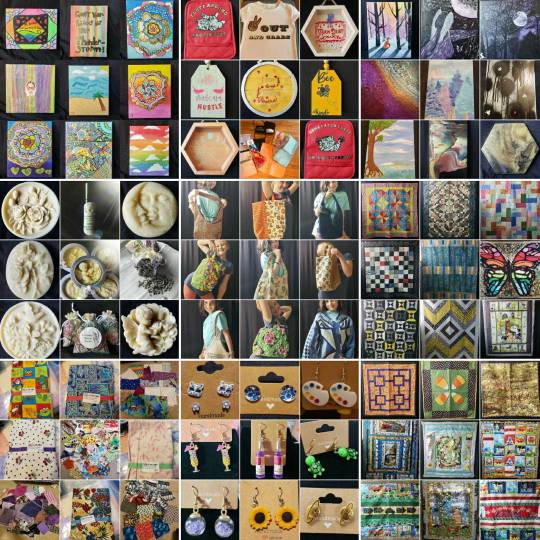
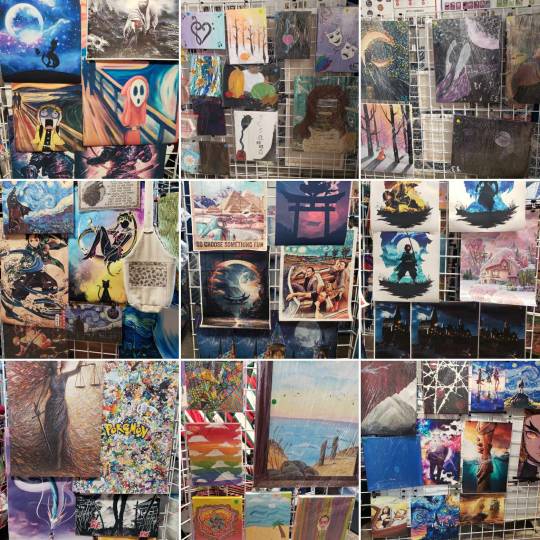



















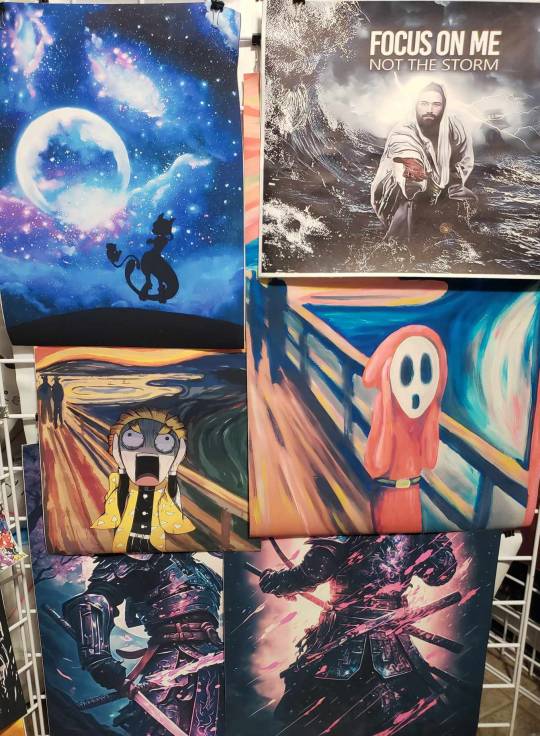








Huge Sale
For Three Days, multiple local business and artists are coming together to offer this Rummage Sale and Craft Sale Event.
Rummage Sale items include gently used: Clothing for Men, Women, and Children. Shoes, Purses, Accessories, Toys, Stuffed Animals, Gym Equipment, Books, DVD's, Board Games, Barbies, Home Furnishings, Kitchen items and more.
The Rummage Sale Section is being hosted by two Groups. Angels by Nature are using all proceeds from their rummage sale to fund their Adopt a Family Christmas Program.
Wonders By Women's rummage sale is being put on by members of WXW. The proceeds go directly to the children and women who contributed the items.
Food Items: Winterstar will be selling freeze dried candies, Wholesome foods will be selling all natural ingredient baked treats.
My Favorite Quilt Shop, from Green Bay, will be selling Heavily Discounted / Final Clearance Fabrics, Quilt Tops, Fabric Panels. Prices Start as low as $1.50
New Bay Art will be selling a multitude of different Resin Art items and decor.
Wonders By Women will be selling hand made Jewelry, Quilts, Stuffed Animals, Candles, Stockings, Quilts, Paintings, Aprons, Home decor', pop culture canvas posters, DIY Diamond Art Kits, Paint By Number Kits, Trading Cards, wind-chimes, sewing kits, and more!
If you are interested in learning more about local female photographers, who can help you out with your family portraits, chiropractic services, parenting groups / events, social events, or real-estate services, we will have information about WXW members who provide these services.
If you are looking for someone who can paint / decorate something for you, or make custom made blankets, candles, art work or other items, we will have information on WXW artists who can provide these services for you!
3 notes
·
View notes